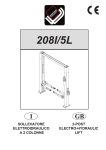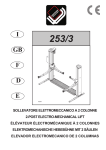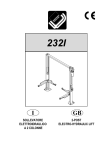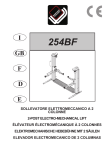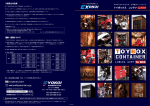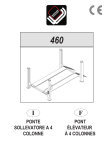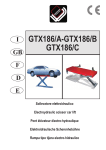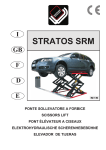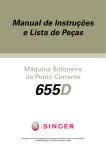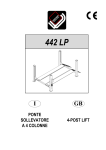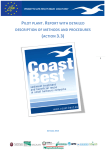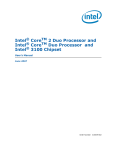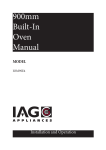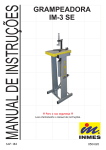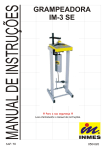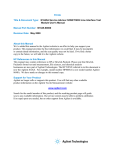Download SF2700/2520
Transcript
SF2700/2520 I/15 I GB SOLLEVATORE ELETTROIDRAULICO A 2 COLONNE 2-POST ELECTRO-HYDRAULIC LIFT Manuale di istruzioni per l’uso e la manutenzione del Instructions and maintenance manual for SOLLEVATORE ELETTROIDRAULICO PER VEICOLI ELECTROHYDRAULIC LIFT FOR VEHICLES Modello SF2700/2520 Model SF2700/2520 Anno di costruzione Year of manufacture COSTRUTTORE: MANUFACTURER: TECALEMIT GARAGE EQUIPMENT CO LTD TECALEMIT GARAGE EQUIPMENT CO LTD EAGLE ROAD,LANGAGE BUSINESS PARK PLYMOUTH,DEVON - PL7 5JY UK EAGLE ROAD,LANGAGE BUSINESS PARK PLYMOUTH,DEVON - PL7 5JY UK Tel.00441752219111 Tel.00441752219111 1° Emissione - 20/07/2015 1° Emissione - 20/07/2015 CENTRO DI ASSISTENZA AUTORIZZATO: AUTHORISED SERVICE CENTER: Rev.0.........................................20/07/2015 1 Indice Contents Imballaggio, trasporto e stoccaggio Pag. 3 Introduzione Pag. 4 Cap.1 Descrizione della macchina Pag. 6 Cap.2 Specifiche tecniche Pag. 8 Packing, transport and storage Page 3 Introduction Chapter 1 Chapter 2 Page 4 Description of the machine Page 6 Technical specifications Page 8 Cap.3 Sicurezza Pag.12 Chapter 3 Safety Page 12 Cap.4 Installazione Pag.19 Chapter 4 Installation Page 19 Cap.5 Funzionamento ed uso Pag.30 Chapter 5 Operating principles and use Page 30 Cap.6 Manutenzione Pag.31 Chapter 6 Maintenance Page 31 Cap.7 Inconvenienti e rimedi Pag.34 Chapter 7 Troubleshooting Page 34 Appendix A Special notes Page 35 Appendix B Spare parts Page 35 Appendice A Appendice B 2 Informazioni particolari Pag.35 Parti di ricambio Pag.35 PACKING, TRANSPORT AND STORAGE IMBALLAGGIO, TRASPORTO E STOCCAGGIO LE OPERAZIONI DI IMBALLAGGIO, SOLLEVAMENTO, MOVIMENTAZIONE, TRASPORTO E DISIMBALLO DEVONO ESSERE AFFIDATE ESCLUSIVAMENTE A PERSONALE CHE SIA ESPERTO IN TALI OPERAZIONI E CHE CONOSCA BENE IL SOLLEVATORE ED IL PRESENTE MANUALE ALL PACKING, LIFTING, HANDLING, TRANSPORT AND UNPACKING OPERATIONS ARE TO BE PERFORMED EXCLUSIVELY BY EXPERT PERSONNEL WITH KNOWLEDGE OF THE LIFT AND THE CONTENTS OF THIS MANUAL IMBALLAGGIO Il sollevatore viene spedito smontato nei seguenti pezzi: PACKING Peso di un pezzo (Kg) 1 1 1 4 1 1 1 1 Colonna lato comando completa di carrello, cilindro idraulico e quadro elettrico: Colonna lato servizio completa di carrello e cilindro idraulico: Trave superiore completa di tubo idraulico e barra fine corsa: Bracci completi di prolunghe e piattello: Kit prolunghe colonne con tubi idraulici: Centralina completa di motore e supporto: Scatola di accessori e viteria: Scatola contenente 4 kit bloccabracci: Kg 475 Kg 469 Kg Kg Kg Kg Kg Kg 85 85 160 40 26 10 Il sollevatore viene inviato in una gabbia di legno (Figura 1) del peso medio di circa 1100 Kg. SOLLEVAMENTO E MOVIMENTAZIONE Le gabbie in legno possono essere sollevate e spostate sia con carrelli elevatori (fig.1) che con gru o carriponte (fig.2). Nel caso di movimentazione con gru o carriponte, le gabbie devono essere sempre imbragate con minimo 2 fasce. Fig.1 The lift is shipped disassembled into the following parts: Weight (Kg) 1 Complete command post, complete with carriage, hydraulic cylinder and control panel 475 kg 1 Commands side post with carriage and hydraulic cylinder 469 kg 1 Upper beam complete with hydraulic horizontal pipe and end-of-stroke-bar 85 kg 4 Arms complete with extensions and plate 85 kg 1 Kit prolongs columns with hydraulic pipes: 160 kg 1 Power unit complete with motor and support 40 kg 1 Accessory package, nuts and bolts 26 kg 1 Box containing 4 arm-locking kits 10 kg The lift is dispatched in a wooden crate (Fig.1), weighing approx. 1100 kg. LIFTING AND HANDLING The wooden crates may be lifted and moved with a lift truck (Fig.1) crane or bridge crane (Fig.2). If either of the latter two are used, crates must be har nessed with at least 2 slings. Fig.2 1100 I mezzi scelti devono essere idonei al sollevamento e allo spostamento in sicurezza, tenendo conto di dimensioni, peso, baricentro, sporgenze e parti delicate da non danneggiare. STOCCAGGIO Gli imballi devono sempre essere conservati in luoghi coperti e protetti, a temperature comprese fra -10°C e +40°C. e non devono essere esposti ai raggi diretti del sole. IMPILAMENTO DEI PACCHI Il tipo di imballo previsto prevede la possibilità di impilare in magazzino fino ad 8 gabbie una sull’altra, purchè vengano correttamente disposte ed assicurate contro la caduta. Nei cassoni dei camion o nei containers si possono impilare fino a 3 gabbie, purchè vengano reggiate bene ed assicurate contro la caduta. The equipment chosen must be suitable for safe lifting and moving, bearing in mind the dimensions and weight. STORAGE Packed machinery must always be kept in a covered, protected place, at a temperature between -10° and +40°, and must not be exposed to direct sunlight. CRATE STACKING The type of packing allows the possibility of stacking up to 8 crates. Up to 3 crates may be stacked one upon the other on lorries or in containers if properly positioned and provided they are restrained to prevent falling. 3 APERTURA DEGLI IMBALLI OPENING THE CRATES All’arrivo verificare che la macchina non abbia subito danni durante il trasporto e che ci siano tutti i pezzi indicati nella lista di spedizione. Le gabbie devono essere aperte adottando tutte le precauzioni per evitare danni alle macchine e ai loro componenti (evitare cadute di pezzi dalla gabbia durante l’apertura). When the crates arrive, check that the machine has not been damaged during transport and that all parts listed are present. The crates must be opened using all possible precautionary measures to avoid damaging the machine or its parts. Make sure that parts do not fall from the crate during opening. ELIMINAZIONE DELL’IMBALLO Il legno della gabbia può essere riutilizzato o riciclato. DISPOSAL OF CRATES The wood of the crates may be re-used or recycled. INTRODUZIONE I ATTENZIONE Questo manuale è stato scritto per il personale di officina addetto all’uso del sollevatore (operatore) e per il tecnico addetto alla manutenzione ordinaria (manutentore) pertanto, prima di effettuare qualsiasi operazione sul sollevatore e/o sul suo imballaggio, occorre leggere attentamente tutto il manuale, poichè esso contiene informazioni importanti per: - LA SICUREZZA DELLE PERSONE addette all’uso ed alla manutenzione ordinaria, - LA SICUREZZA DEL SOLLEVATORE, - LA SICUREZZA DEI VEICOLI SOLLEVATI. CONSERVAZIONE DEL MANUALE Il manuale è parte integrante del sollevatore e deve sempre accompagnarlo, anche in caso di vendita. Esso deve sempre essere conservato in vicinanza del sollevatore, in luogo facilmente accessibile. L’operatore ed il manutentore devono poterlo reperire e consultare rapidamente in qualsiasi momento. SI RACCOMANDA, IN PARTICOLARE, UNA LETTURA ATTENTA E RIPETUTA DEL CAPITOLO 3, CHE CONTIENE IMPORTANTI INFORMAZIONI E AVVISI RELATIVI ALLA SICUREZZA. INTRODUCTION I WARNING This manual has been prepared for workshop personnel expert in the use of the lift (operator) and technicians responsible for routine maintenance (maintenance fitter); read the manual before carrying out any operation with the lift and/or the packing. This manual contains important information regarding: THE PERSONAL SAFETY of operators and maintenance workers, LIFT SAFETY, THE SAFETY OF LIFTED VEHICLES CONSERVING THE MANUAL The manual is an integral part of the lift , which it should always accompany , even if the unit is sold. The manual must be kept in the vicinity of the lift, in an easily accessible place. The operator and maintenance staff must be able to locate and consult the manual quickly and at any time. ATTENTIVE AND REPEATED READING OF CHAPTER 3, WHICH CONTAINS IMPORTANT INFORMATION AND SAFETY WARNINGS, IS PARTICULARLY RECOMMENDED. Il sollevatore è stato progettato e costruito rispettando quanto segue: Lift rack has been designed and built in compliance with the following: LEGGI: Direttive europee: 2004/108/CE - 2006/42/CE - 2006/95/CE NORME TECNICHE: Norme europee: EN 1493:2010 - EN ISO 12100/1 2005 - EN ISO 12100/2 2005 IMPIANTO ELETTRICO: UNI EN 60204-1 LAWS: European directives:2004/108/CE - 2006/42/CE - 2006/95/CE TECHNICAL STANDARDS: European standards: EN 1493:2010 - EN ISO 12100/1 2005 - EN ISO 12100/2 2005 ELECTRICAL SYSTEM: UNI EN 60204-1 4 Il sollevamento, il trasporto, il disimballo, il montaggio, l’installazione e la messa in servizio, la taratura e le registrazioni iniziali, la manutenzione STRAORDINARIA, la riparazione, la revisione, lo spostamento e lo smantellamento del sollevatore devono essere eseguiti dai tecnici specializzati dei RIVENDITORI AUTORIZZATI o dei CENTRI ASSISTENZA AUTORIZZATI dal Costruttore (vedere centro assistenza autorizzato indicato nel frontespizio): The lifting, transport, unpacking, assembling, installation, starting up, initial adjustment and testing, EXTRAORDINARY maintenance, repair, overhauls, transport and dismantling of the lift must be performed by specialised personnel from the LICENSED DEALER or a SERVICE CENTRE authorised by the manufacturer (see authorised dealer on frontispiece). Il costruttore non risponde di alcun danno a persone, veicoli od oggetti causati dagli interventi sopracitati se effettuati da personale non autorizzato o da un uso improprio o non consentito del sollevatore. The manufacturer declines all responsibility for injury to persons or damage to vehicles or objects when any of the above mentioned operations has been performed by unauthorised personnel or when the rack has been subject to improper use. Per tutte queste attività vengono indicati, nel presente manuale, soltanto gli aspetti (operativi e di sicurezza) che possono essere utili anche all’operatore ed al manutentore per comprendere meglio la struttura ed il funzionamento del sollevatore e per un suo migliore utilizzo. This manual indicates only the operative and safety aspects that may prove useful to the operator and maintenance worker, in better understanding the structure and operation of the lift and for best use . Per comprendere il linguaggio adottato nel presente manuale, l’operatore deve possedere esperienza specifica nelle attività di officina, di assistenza, manutenzione e riparazione dei veicoli nonchè la capacità di interpretare correttamente i disegni e le descrizioni riportate nel manuale e la conoscenza delle norme antinfortunistiche generali e specifiche vigenti nel paese in cui viene installato il sollevatore. Gli stessi criteri valgono per la scelta del tecnico manutentore che dovrà, inoltre, possedere le conoscenze tecniche specifiche e specialistiche (mec caniche, elettriche) necessarie per effettuare in sicurezza gli interventi previsti nel manuale. In order to understand the terminology used in this manual, the operator must have specific experience in workshop, service, maintenance and repair activities, the ability to interpret correctly the drawings and descriptions contained in the manual and be acquainted with the general and specific safety rules relevant to the country in which the machine has been installed. The same applies to the maintenance fitter, who must also possess specific and specialised knowledge (mechanical, engineering) needed to perform the operations described in the manual in complete safety. Nel testo del manuale troverete spesso le diciture “operatore” e “manutentore” il cui significato è il seguente: OPERATORE: persona addetta all’uso del sollevatore. MANUTENTORE: persona addetta alla manutenzione ordinaria del sollevatore. The words “operator” and “maintenance fitter” used in this manual are construed as follows: OPERATOR: person authorised to use the lift MAINTENANCE FITTER: person authorised for routine maintenance of the lift. 5 CHAPTER 1 DESCRIPTION OF THE MACHINE CAP.1. DESCRIZIONE DELLA MACCHINA The 2-post electro-hydraulic lift is a fixed installation. This means that it is anchored to the ground and designed and built for lifting and positioning automobiles and vans at a certain height off the ground. The lift consists of the following main parts: Il sollevatore elettroidraulico a 2 colonne è fisso, cioè ancorato al suolo ed è progettato e costruito per il sollevamento e lo stazionamento in quota di autoveicoli e furgoni. Il sollevatore è composto, principalmente da : · · · · · gruppo struttura fissa (colonne e trave superiore) gruppi mobili ( carrelli + bracci ) gruppi di sollevamento (2 cilindri idraulici + centralina); quadro comando sicurezze. · · · · · fixed structure (posts + upper beam); mobile units (carriage + arms); lift units (2 hydraulic cylinders + power unit); control box; safety devices. Figures 3 and 4 illustrate the various parts of the lift and the work areas reserved for use by operators around the lift. Nelle figure 3 e 4 sono indicate le varie parti che compongono il sollevatore e le zone di lavoro consentite e riservate al personale addetto, attorno al sollevatore stesso. Command side: this side of the lift includes the area reserved for the operator to access the control box. Service side: this is the opposite side to the command side. Lato comando: è il lato del sollevatore che comprende la zona riservata all’operatore in cui si accede al quadro comandi Lato servizio: è il lato opposto a quello comando. Lato servizio Service side Lato comando Command side Fig.3 FIXED STRUCTURE (Fig.4) GRUPPO STRUTTURA FISSA (Vedere Fig.4) This structure consists of: E’ costituito da : · 2 Posts, (service and command side post) built with bent steel plate. The base is welded to a drilled plate to be anchored to the floor. The electric control box and the hydraulic power unit are attached to the command post. Inside each post are the moving parts to lift the vehicles. The control panel and the hydraulic unit are fixed to the command post. · 2 Colonne, una lato comando (1) e una lato servizio (2), in lamiera di acciaio piegata, alla cui base è saldata una piastra con fori per il fissaggio al pavimento mediante tasselli di ancoraggio. All’interno di ogni colonna si trovano i gruppi mobili di sollevamento dell’automezzo. Alla colonna comando sono fissati il quadro elettrico di azionamento e la centralina idraulica. · Una trave superiore (3) in lamiera piegata che, mediante bullonatura,collega le colonne nella loro estremità superiore. · An upper beam (3) built with bent steel plate, connecting the upper posts with bolts. 10 9 10 2 3 8 4 6 1 8 7 5 Fig.4 10 6 9 10 4 GRUPPI MOBILI (Vedere Fig.4) MOVING UNITS (see fig.4) Ciascuno è costituito da : Each unit consists of: · Un carrello (4) in lamiera di acciaio saldata, collegato nella parte superiore ad un cilindro idraulico e nella parte inferiore, mediante perni, ai bracci di sollevamento. · one carriage (4) built with welded steel plate, connected at the top to a hydraulic cylinder, and at the bottom, to the lift arms by means of pins. Il carrello scorre lungo la colonna, guidato, all’ interno di essa, da pattini in materiale plastico. The carriage moves along the post, guided by plastic sliding pads, located inside the post itself. · Due bracci telescopici (5) e (6), costruiti in tubolare di acciaio, recanti ad una estremità il piattello regolabile in altezza (7) per la presa della macchina e dalla parte opposta gli attacchi con il foro di collegamento con il carrello. · Two telescopic arm (5) and (6), built with tubular steel with a pad (7) at each end that can be height adjusted to hold the car and on the opposite side the carriage connection hole. GRUPPO SOLLEVAMENTO (Vedere Fig.4) it consists of: E’ costituito da: · 2 cilindri idraulici (8), per il sollevamento dei carrelli, ancorati alle piastre di base delle colonne. · 1 centralina idraulica (vedi fig.5), posta sulla colonna comando, per l’ azionamento dei cilindri. LIFT UNIT(see fig.4) · 2 hydraulic cylinders (8), to lift the carriages anchored to the post basis pads. · 1 hydraulic unit (see. fig. 5), on the command side, to set the cylinders run. HYDRAULIC POWER UNIT (Fig.5) The hydraulic power unit consists of: CENTRALINA IDRAULICA (Fig.5) La centralina é composta da: · Un motore elettrico di comando (1). · Una pompa idraulica ad ingranaggi (2). · Un’ elettrovalvola di discesa (3) dotata di un dispositivo di scarico manuale dell’ olio (vedi cap. Uso e Manutenzione). · Una valvola di massima pressione (4). · Un serbatoio olio (5). · Un tubo flessibile (6) di mandata (e recupero) olio al circuito di distribuzione ai cilindri. N.B: il tubo di mandata olio può trovarsi in pressione. · an electric motor (1), · a geared hydraulic pump (2) · descent electro-valve (3) equipped with a manual oil drain valve (see the Use and Maintenance chapter), · a maximum pressure valve (4), · oil tank (5) · an oil delivery and return flexible pipe (6) to the cylinders feeding circuit Note: The oil delivery pipe may be under pressure. CONTROL BOX (Fig.6) QUADRO DI COMANDO (Fig.6) The panel that houses the electric control box contains the following: Sul pannello del quadro elettrico di comando sono installati : · · · · · · · · L’interrutore generale (QS). Il pulsante di salita (SB1). Il pulsante di stazionamento (SB3). Il pulsante di discesa (SB2). Main switch (QS) Rise push button (SB1) Parking push button (SB3) Descent push button (SB2) Fig.5 Centralina idraulica QS 1 4 6 3 2 SB1 5 SB2 SB3 Fig.6 Hydraulic power unit SICUREZZE Le sicurezze sono costituite da : Quadro comando Control Panel SAFETY DEVICES The safety devices include: · Un dispositivo di sicurezza meccanica per il carrello. · Un sistema di bloccaggio bracci. · Un dispositivo di sincronismo per la corsa dei carrelli costituito da un sistema di 2 funi (rif.9 Fig.4) e 6 carrucole di rinvio (rif.10 Fig.4). · Sirena acustica. · Le sicurezze elettriche · Le sicurezze sull’ impianto idraulico. · Un sensore per la differenza di livello fra i carrelli e l’allentamento e/o la rottura delle funi di sincronismo. · Mechanical safety device for carriage. · Arms locking system. · A synchronous device to control the carriages movement. The system consists of 2 cables (ref. 9, fig.4) and 4 return pulleys (ref.10, fig.4) · Buzzer warning system · General electric safety devices. · General hydraulic safety devices. · A sensor for the level difference between the carriage and the synchronized cables loosening and/or breaking. Queste sicurezze saranno sviluppate in maggior dettaglio nei capitoli seguenti. These safety devices will be described in further detail in the following chapters. 7 CAP.2 SPECIFICHE TECNICHE CHAPTER. 2 TECHNICAL SPECIFICATIONS PORTATA:..........................................7000 Kg (68647 N) CAPACITY:.........................................7000 Kg (68647 N) Tempo di salita con motore trifase ..................... Tempo di discesa ............................................... 44 sec 42 sec Rise time with three-phase motor..........................44 sec. Descent time ..................................................... 42 sec. Peso totale del sollevatore..........................circa 1680 Kg Rumorosità ..................................................<70dB(A)/1m Temperatura di funzionamento :.................-10°C / +50°C Pressione di lavoro......................................210 bar Total lift weight...........................................about 1680 Kg Noise ...........................................................<70dB(A)/1m Operating temperature: ................................-10°C/+50°C Working pressure ........................................210 bar Ambiente di lavoro: locale chiuso. Work environment: closed room. Fig.7 Dimensioni ed ingombri Fig.7 Dimensions and overall clearances MOTORE ELETTRICO: ELECTRIC MOTOR: Trifase Potenza del motore elettrico 3 kw Tensione Frequenza Assorbimento 230-400V trif.+/-5% 50 HZ 230V:15A 400V:8,7A 4 1400 B14 IP54 90L4 N° poli Velocità Forma costruttiva Classe di isolamento Tipo Il collegamento del motore deve essere eseguito riferendosi agli schemi elettrici allegati. Il senso di rotazione del motore deve coincidere con quello indicato dalla freccia sulla pompa; in caso contrario modificare i collegamenti elettrici (Vedere Cap.4 INSTALLAZIONE- Allacciamento impianto elettrico). 8 Three-phase Electric motor power rating Voltage Frequency Absorption N° of poles Speed Construction size Insulation class Type 3 KW 230-400V 3ph.+/- 5% 50 Hz 230V:15A 400V: 8,7A 4 1400 RPM B14 IP54 90L4 The motor must be connected with reference to the attached wiring diagrams. The motor rotation direction must be the same as shown by the arrow on the pump; if not, modify the electrical connections (see Ch.4, INSTALLATION-electric plant connection) POMPA della centralina idraulica: Hydraulic unit PUMP MOTORE Trifase MOTOR 3-ph. Tipo 20 Type 20 Modello 10A7,4X348N Model 10A7,4X348N Cilindrata 7.4 cm /g Size 7.4 cm /g Taratura valvola di massima 210 bar Relief valve set-up 210 bar 3 OLIO Il serbatoio dell’ olio contiene olio idraulico a base minerale secondo la normativa ISO/DIN 6743/4 con grado di contaminazione non superiore alla classe 18/15 secondo la normativa ISO 4406 come IP HYDRUS OIL 32, SHELL TELLUS OIL T32 od equivalenti. SCHEMA OLEODINAMICO 3 OIL The oil reservoir contains hydraulic mineral oil in accordance with ISO/DIN 6743/4 with a level of contamination that does not exceed class 18/15 according to ISO 4406, for example IP HYDRUS OIL 32; SHELL TELLUS OIL T32 or equivalent. HYDRAULIC OIL DIAGRAM Fig.8 Schema oleodinamico Rif.to 1 2 3 4 5 6 7 8 9 10 Fig.8 Oleodynamic scheme Descrizione Cilindri operatori a semplice effetto Valvola di regolazione flusso Elettrovalvola di scarico Valvola di non ritorno Valvola di massima pressione e scarico Pompa Motore Filtro Valvole di blocco Serbatoio Ref. 1 2 3 4 5 6 7 8 9 10 Description Operating cylinder with simple effect Flow control valve Drain electro-valve Check valve Maximum pressure drain valve Pump Motor Filter Lock valve Tank 9 SCHEMI ELETTRICI Fig.9 THREE-PHASE wiring diagram. Schema elettrico TRIFASE WIRING DIAGRAMS Rif./Ref. Descrizione FU B6547+B2869 FU1 B6511+B5289 FU2 B6511+B5289 FU3 B6511+B6579 QS1 B0557 HA1 B2681 SBS-D D2166 SBP D2166 KA1 D2509 KA2 D2509 PORTA FUSIBILE TRIPOLARE (non fornito) 3x16A RIT PORTA FUSIBILE 1 A RIT, PORTA FUSIBILE 1 A RIT, PORTA FUSIBILE 4A RIT, INTERRUTTORE GENERALE 16A BUZZER QM1 B1325R PULSANTE SALITA-DISCESA PULSANTE DI STAZIONAMENTO RELE' E ZOCCOLO 24VAC 2XSC RELE' E ZOCCOLO 24VAC 2XSC ELETTROVALVOLA DISCESA ELETTROMAGNETE COLONNA COMANDI ELETTROMAGNETE COLONNA SERVIZIO FINECORSA FUNE QM5 B1325R FINECORSA SALITA QM11 B1325R QMT B6661 FINECORSA DISCESA /STAZIONAMENTO FINECORSA TETTO YV D YA C1 YA C2 M1 MOTORE ELETTRICO ST1 PASTIGLIA TERMICA 10 Description Marca/Brand Articolo/Article Q.tà/Q.ty TIPI DI VEICOLI SOLLEVABILI E INGOMBRI VEHICLE WEIGHT AND SIZE Il sollevatore si adatta praticamente a tutti i veicoli di peso non superiore a 7000 Kg e le cui dimensioni non eccedano quelle riportate di seguito. Lift rack can be adapted to virtually all vehicles not heavier than 7000 kg, the dimensions of which do not exceed the following. DIMENSIONI MASSIME DEI VEICOLI DA SOLLEVARE MAXIMUM DIMENSIONS OF VEHICLES TO BE LIFTED I WARNING I ATTENZIONE Eventuali carrozzati speciali possono essere sollevati tenendo però conto della portata del sollevatore. The underbody of cars with low ground clearance may interfere with the structure of the lift. Pay particular attention in the case of low body sport cars. Always keep the capacity of the lift in mind in the case of vehicles with particular characteristics. Anche la zona di rischio per le persone dovrà essere adeguata alle dimensioni speciali del veicolo. The danger zone will be determined by the dimensions of the vehicle. Gli schemi seguenti riportano i criteri per definire i limiti di impiego del sollevatore. The diagrams below include the criteria for defining the limits of use of the car rack. L’altezza minima da terra può interferire con le strutture del sollevatore. Fare attenzione soprattutto alle autovetture sportive. C B A Min.(mm) A B Fig.11 Max.(mm) —- 2300 —- 3800 Fig.11 Minimum and maximum dimensions Misure minime e massime PER INGOMBRI MAGGIORI VERIFICARE IL CARICO MASSIMO E LO SBILANCIAMENTO DEL CARICO. CHECK MAXIMUM LOAD CAPACITY AND LOAD DISTRIBUTION IN CASE OF LARGER VEHICLES. PESI MASSIMI DEI VEICOLI DA SOLLEVARE MAXIMUM WEIGHT OF THE VEHICLE TO BE LIFTED Fig.12 Distribuzione dei pesi 5250 Fig.12 1750 1750 Weight distribution 5250 I MAX. 7000 Kg.! 11 CAP.3 SICUREZZA E’ estremamente importante leggere questo capitolo attentamente ed in ogni sua parte poichè contiene importanti informazioni sui rischi che operatore e manutentore possono correre in caso di un uso errato del ponte sollevatore. Nel testo che segue troverete chiare spiegazioni su alcune situazioni di rischio o pericolo che si possono verificare durante l’uso e la manutenzione del sollevatore, sui dispositivi di sicurezza adottati e sul loro uso corretto, sui rischi residui e sui comportamenti da tenere (precauzioni generali e specifiche per eliminarli o neutralizzarli). I ATTENZIONE: CHAPTER 3 SAFETY It is vital to read this chapter of the manual carefully and from beginning to end as it contains important information regarding the risks that the operator or maintenance fitter may be exposed to in the eventuality that the lift is used incorrectly. The following text contains clear explanations regarding certain situations of risk or danger that may arise during the operation or maintenance of the lift, the safety devices installed and the correct use of such systems, residual risks and operative procedures to use (general and specific precautions to eliminate potential hazards). I WARNING: Il sollevatore è stato progettato e costruito per il sollevamento e lo stazionamento in quota dei veicoli in ambiente chiuso. Ogni altro uso non è consentito ed in particolare esso non è idoneo per operazioni di: - lavaggio e verniciatura; - ponteggio o sollevamento di persone; - pressa per schiacciare; - montacarichi; - CRIC per sollevare o cambiare ruote. Lift is designed and built to lift vehicles and hold them in the elevated position in a closed workshop. All other uses are unauthorised. In particular, the lift is not suitable for: - washing and respray work; - creating raised platforms or lifting personnel; - use as a makeshift press for crushing purposes; - use as goods lift; - use as a jack for lifting vehicles or changing wheels. Il costruttore non risponde di alcun danno a persone, veicoli od oggetti causati dall’uso improprio o non consentito dei sollevatori. The manufacturer disclaims all liability for injury to persons or damage to vehicles and other property caused by the incorrect and unauthorised use of the lift. É estremamente importante che in fase di salita o discesa l’operatore agisca soltanto dalla postazione di comando indicata in fig.13. É vietato a chiunque sostare entro la zona di rischio indicata in figura 13. In fase di lavoro la presenza di persone sotto il veicolo è ammessa soltanto quando il veicolo è già sollevato. During lift and descent movements, the operator must remain in the command station as defined in figure 13. The presence of persons inside the danger zone indicated in the same figure is strictly prohibited. The presence of persons beneath the vehicle during operations is permitted only when the vehicle is parked in the elevated position. I ATTENZIONE: LA PRESENZA DI PERSONE SOTTO IL VEICOLO SOLLEVATO E’ AMMESSA SOLTANTO QUANDO IL SOLLEVATORE E’ IN STAZIONAMENTO SUI MARTELLETTI DI SICUREZZA. NON UTILIZZARE LA MACCHINA SENZA LE PROTEZIONI O CON LE PROTEZIONI DISATTIVATE. IL MANCATO RISPETTO DI QUESTE NORME PUO’ RECARE GRAVI DANNI ALLE PERSONE, AL SOLLEVATORE ED AI VEICOLI SOLLEVATI. Zona di rischio Danger zone Fig.13 I WARNING: THE PRESENCE OF PERSONS BENEATH THE VEHICLE IS PERMITTED ONLY WHEN THE LIFT IS IN THE PARKING POSITION ON THE SAFETY WEDGES. DO NOT USE THE LIFT WITHOUT PROTECTION DEVICES OR WITH THE PROTECTION DEVICES INHIBITED. FAILURE TO COMPLY WITH THESE REGULATIONS CAN CAUSE SERIOUS INJURY TO PERSONS, AND IRREPARABLE DAMAGE TO THE LIFT AND THE VEHICLE BEING LIFTED. Zone di lavoro Fig.13 Working areas Zona operatore Operator zone 12 PRECAUZIONI GENERALI GENERAL PRECAUTIONS L’operatore ed il manutentore sono tenuti al rispetto delle prescrizioni contenute in leggi e norme antinfortunistiche vigenti nel paese in cui è installato il sollevatore. The operator and the maintenance fitter are required to observe the prescriptions of accident prevention legislation in force in the country of installation of the lift. Devono inoltre: Furthermore, the operator and maintenance fitter must: · operare sempre dalle postazioni di lavoro previste ed indicate nel manuale; · non rimuovere nè disattivare i carter e le protezioni meccaniche, elettriche, o di altra natura; · prestare attenzione agli avvisi di sicurezza riportati nelle targhette applicate sulla macchina e nel manuale. · Always work in the scheduled working area as shown in the manual. · never remove or deactivate the guards and mechanical, electrical, or other types of safety devices; · read the safety notices affixed to the machine and the safety information in this manual. Nel testo del manuale gli avvisi di sicurezza saranno evidenziati nelle forme seguenti: In the manual all safety notices are shown as follows: PERICOLO: Indica un pericolo imminente che può causare danno alle persone (gravi lesioni o anche la morte). DANGER: Indicates imminent danger that can result in serious injury or death. ATTENZIONE: Indica situazioni e/o comportamenti rischiosi che possono causare danni alle persone (lesioni più o meno gravi e/o anche la morte). WARNING: Indicates situations and/or types of manoeuvres that are unsafe and can cause injuries of various degrees or death. CAUTELA: Indica situazioni e/o comportamenti rischiosi che possono causare danni di minore gravità alle persone e/o danni al sollevatore, al veicolo o ad altre cose. RISCHIO DI FOLGORAZIONE: è un particolare avviso di sicurezza che viene riportato sul sollevatore, tramite targhetta, in alcuni punti dove è particolarmente elevato il rischio di forti scosse elettriche. CAUTION: Indicates situations and/or types of manoeuvres that are unsafe and can cause minor injury to persons and/or damage the lift, the vehicle or other property. RISK OF ELECTRIC SHOCK: specific safety notice affixed to the lift in areas where the risk of electric shock is particularly high. RISCHI E PROTEZIONI Vediamo ora quali rischi possono correre gli operatori o il manutentore in fase di stazionamento del veicolo sul sollevatore e quali protezioni sono state adottate dal costruttore per ridurre al minimo tali rischi: SPOSTAMENTI LONGITUDINALI E LATERALI Gli spostamenti longitudinali sono i movimenti in avanti o all’indietro del carico. Gli spostamenti laterali sono i movimenti verso destra o verso sinistra che il veicolo può avere, specialmente durante la fase di salita sul sollevatore. Essi sono evitabili posizionando in maniera corretta il veicolo sui piattelli dei bracci, regolando alla stessa altezza (avvitando o svitando) i piattelli stessi. Lo spostamento dell’automezzo sui bracci, la regolazione dei bracci e dei piattelli deve essere fatto esclusivamente a bracci totalmente abbasssati e cioè con i piattelli liberi da qualunque contatto con il mezzo. RISKS AND PROTECTION DEVICES We shall now examine the risks to which operators or maintenance fitters may be exposed when the vehicle is immobilised in the raised position, together with the protection devices adopted by the manufacturer to reduce all such hazards to the minimum: LONGITUDINAL AND LATERAL MOVEMENT Longitudinal movement is considered the backward and forward shifting of the load. Lateral movement implies the shifting to the left or right of the vehicle, especially during the lifting phase on the rack. These movements can be avoided by positioning the vehicle correctly on the arm disk support plates, which must be previously adjusted to the same height (by loosening or tightening) as the vehicle. Do not move the vehicle in relation to the arms or adjust arms and disk support plates until the arms have been totally lowered, i.e. the disk support plates must be free from all contact with the vehicle. Fig.14 Risk of vehicle fall Fig.14 Rischio di caduta del veicolo I ATTENZIONE NON TENTARE DI SPOSTARE IL MEZZO QUANDO I PIATTELLI DI APPOGGIO SONO GIÀ A CONTATTO CON QUESTO. I WARNING DO NOT ATTEMPT TO MOVE THE VEHICLE WHEN IT IS RESTING ON THE DISK SUPPORT PLATES. 13 É estremamente importante posizionare il mezzo sul sollevatore in modo da avere una corretta ripartizione dei pesi sui bracci (Fig.15) It is very important to position the vehicle on the lift so that the weight is correctly distributed on the arms (fig.15). For persons and equipment safety, it is important that: Per la sicurezza delle persone e dei mezzi è importante che: · people stay outside the danger zone while the vehicle raising (fig.13) · the engine is off, the clutch engaged and the parking brake pulled. · the vehicle is correctly positioned (fig.15) · only authorised vehicles (fig.11-12) are raised without exceeding the rated capacity and overall dimensions. · si rispetti la zona di rischio durante il sollevamento (Fig.13) · il motore sia spento,la marcia innestata ed il freno a mano tirato. · il veicolo sia posizionato in maniera corretta (Fig.15) · vengano sollevati soltanto i veicoli ammessi (fig.11-12) senza superare portata ed ingombri previsti. Fig.15 Correctly loaded vehicle Fig.15 Veicolo caricato correttamente RISCHI IN FASE DI SOLLEVAMENTO DEL VEICOLO Contro i sovraccarichi in peso e contro eventuali rotture sono stati adottati i seguenti dispositivi di sicurezza: · in caso di sovraccarico sul motore interviene il relè termico nel quadro elettrico. · in caso di sovraccarico del sollevatore interviene la valvola di massima pressione (rif.1 Fig.16). · nel caso dovesse verificarsi improvvisamente una grossa perdita nel circuito idraulico (es.: rottura di un tubo), intervengono le valvole di blocco poste nella parte inferiore dei cilindri (rif.1 Fig.17). · nel caso dovesse verificarsi la rottura e/o l’allentamento delle funi di sincronismo interviene il sensore (rif.1 Fig. 17a) applicato sulla trave superiore che azione il microinterruttore di sicurezza funi e sicurezza salita (rif.2 Fig. 17a). RISKS WHILE THE VEHICLE IS BEING RAISED The following safety devices have been installed to protect against overweight conditions and equipment failure: · the thermal relay in the electric box will trip if the motor is overloaded. · the maximum pressure valve (1, fig.16), located on the hydraulic oil power unit, will trip if the lift is overloaded. · In case of a sudden, great leakage in the hydraulic circuit ( a broken pipe), the blocking valves, at the bottom of each cylinder, will trip (ref.1, fig.17). · In case of a sudden, synchronized cables loosening and/or breaking, the sensor intervenes (ref.1 Fig. 17a) on the upper beam action the microswitch safety cables and safety lift (ref.2 Fig. 17a). 1 1 Fig.17 Fig.16 2 1 Fig. 17a 14 · in caso di avaria completa dei microinterruttori, i carrelli si fermerebbero pochi mm più in alto perché i cilindri idraulici andrebbero a fine corsa facendo intervenire la valvola di massima pressione sulla centralina. 2 1 3 · If the hydraulic cylinder breaks, the safety wedges will trip (ref.1, see.fig.18), located inside the posts (2). The wedges are pushed by the spring (3) and immediately stop the carriages (4) preventing their descent 4 1 2 CARRELLO IN FASE ARRESTO O SALITA STOPPING OR RISING CARRIAGE CARRELLO IN FASE DI DISCESA DESCENDING CARRIAGE Fig.19 Fig.18 · nel caso vengano sollevati autoveicoli di altezza superiore a 1,5 metri, la salita viene interrotta dalla “barra di finecorsa” (rif.1 Fig.20) che, spinta dal veicolo, agisce sui microinterruttori. · in caso di extra corsa della parte mobile, sono stati previsti due microinterruttori (rif.2 e 3 Fig.20) collegati in serie tra loro e montati nella parte superiore della colonna lato comando; essi sono azionati normalmente dall’ “azionatore” (rif.1 Fig. 19) montato sul carrello lato comando; nel caso che il primo microinterruttore non dovesse funzionare, il secondo interviene dopo circa 30 mm di corsa del carrello. · in caso di rottura del cilindro idraulico intervengono automaticamente i martelletti di sicurezza (rif.1) (vedere Fig.18), posti all’ interno delle colonne (2), che, spinti dalla molla (3), arrestano immediatamente i carrelli (4) impedendone la discesa. · When vehicles higher than 1.5m are lifted, the rise is interrupted by the “end-of-stroke bar “(ref.1, fig.20), which, pushed by the vehicle, works on the limit switches. · if the moving part exceeds its travel distance, on the upper part of the command post there are two limit switches (ref.2 and 3, fig.20) connected in series and are usually set working by the “actuator” (ref.1 fig.19) on the command side carriage. If the first limitswitch did not work, the second one would trip after 30 sec. of carriage run. · in case of total breakdown of the limit switches, the carriages will stop a few mm higher, because the hydraulic cylinders, come to the end of their stroke, which causes the maximum pressure valve (on hydraulic unit) to trip. 3 Fig.20 1 2 15 RISCHI DIRETTI ALLE PERSONE RISKS TO PERSONS In questo paragrafo verranno illustrati i rischi che operatore, manutentore e chi si trova nell’area di lavoro del sollevatore, possono correre a causa di un uso non corretto del sollevatore stesso. This paragraph illustrates risks to which the operator, maintenance worker or any person near the operating area of the lift may be exposed in the case of improper use of equipment. RISCHIO DI SCHIACCIAMENTO DELL’OPERATORE dovuto ad una errata posizione dell’operatore addetto al quadro comandi. Durante la fase di discesa dei bracci e del veicolo l’ operatore non deve mai portarsi sotto le parti mobili in fase di discesa ma operare soltanto dalla zona comando (Fig.21). Fig.21 Rischio di schiacciamento dell’operatore RISK OF CRUSHING (OPERATOR) Possible if the operator controlling the lift is not in the specified position at the command panel. When the platforms and vehicle are descending, the operator must never be partly or completely underneath the moving structure. During this phase the operator must remain in the command zone fig.21. Fig.21 Operator crushing risk RISCHIO DI SCHIACCIAMENTO DEL PERSONALE IN GENERE RISK OF CRUSHING (PERSONNEL) Durante la fase di discesa del sollevatore e del veicolo il personale non deve sostare in zone interessate dalle traiettorie di discesa (Fig.22). L’operatore deve manovrare solo dopo essersi accertato che nessuna persona sia in posizioni pericolose. When the platforms and vehicle are descending personnel are prohibited from entering the area beneath the moving parts of the lift (fig.22). The lift operator must not start the manoeuvre until it has been clearly established that there are no persons in potentially dangerous positions. Fig.22 Generic people crushing risk Fig.22 Rischio di schiacciamento del personale in genere RISCHIO DI URTO Dovuto alle parti del sollevatore o del veicolo posizionate ad altezza d’uomo. Quando, per ragioni di lavoro, il sollevatore viene fermato a quote relativamente basse (inferiori a 1,75 m dal suolo) vi è il rischio di urtare contro le parti non evidenziate da particolari colorazioni (Fig.23). Fig.23 Rischio di urto RISCHIO DI SPOSTAMENTO DEL VEICOLO Dovuto ad operazioni da compiere e che generano spinte sul veicolo (Fig.24). Se il veicolo é di dimensioni o pesi ragguardevoli uno spostamento può rappresentare una situazione di sovraccarico o sbilanciamento non previsto pertanto evitare in maniera assoluta tali manovre. Fig.24 Rischio di spostamento del veicolo 16 RISK OF IMPACT Caused by parts of the lift or the vehicle that are positioned at head height. When, due to operational reasons, the lift is immobilised at relatively low elevations (less than 1.75 m from the ground) personnel must be careful to avoid impact with parts of the machine not marked with special hazard colouring (Fig.23). Fig.23 Impact risk RISKS DUE TO VEHICLE MOVEMENT Movement may be caused during operations which involve force sufficient to move the vehicle (Fig.24). If the vehicle is of considerable dimensions or weight, movement may lead to overloading or unbalancing; all measures must be taken to avoid such an occurrence. Fig.24 Vehicle movement risk RISCHIO DI CADUTA DEL VEICOLO DAL SOLLEVATORE. RISK OF VEHICLE FALLING FROM LIFT Che può essere causato dal posizionamento non corretto del veicolo sui piattelli dei bracci, da un posizionamento non corretto del veicolo rispetto al sollevatore (Fig.25) o da dimensioni del veicolo non compatibili con lo stesso sollevatore. This risk could be caused by the incorrect positioning of the vehicle on the arm disk support plates (fig.25) or incorrect positioning of the arm disk support plates in relation to the lift. Fig.25 Fig.25 Rischio di caduta del veicolo E’ VIETATO SALIRE SUL VEICOLO E/O METTERLO IN MOTO CON IL SOLLEVATORE INNALZATO (Fig.26). Risk of vehicle fall NEVER BOARD THE VEHICLE AND/OR TURN THE ENGINE ON WHEN LIFT IS RAISED (fig.26). Fig.26 NON LASCIARE OGGETTI APPOGGIATI ALLE COLONNE O NELLA ZONA DI DISCESA DELLE PARTI MOBILI in quanto si può avere il blocco della discesa,o la caduta del veicolo (Fig.27). NEVER LEAN OBJECTS AGAINST THE POSTS OR LEAVE THEM IN THE AREA WHERE MOVING PARTS ARE LOWERED; this could hamper lowering or cause the vehicle to fall from the rack (fig.27). Fig.27 RISCHIO DI SCIVOLAMENTO Dovuto a zone del pavimento sporche di lubrificanti (Fig.28). TENERE PULITA LA ZONA SOTTO E VICINA AL SOLLEVATORE pulendo le MACCHIE D’OLIO. Al fine di evitare il rischio di scivolamento utilizzare i mezzi individuali previsti (scarpe antinfortunistiche). Fig.28 Rischio di scivolamento SLIPPING This risk may arise due to spillage of lubricants in the surrounding area (fig.28). ALWAYS KEEP THE AREA SURROUNDING THE LIFT CLEAN by removing all OIL SPILLS. To avoid the risk of slipping, make use of the recommended personal protection (anti-slip footwear). Fig.28 Skidding risk 17 RISCHIO DI FOLGORAZIONE RISK OF ELECTRIC SHOCK Accanto a parti del sollevatore in cui si trovano fili elettrici evitate getti d’acqua, di vapore (da pulitrice a vapore), di solventi o vernici nella zona del sollevatore ed in particolar modo nelle immediate vicinanze del quadro elettrico (Fig.29). Risk of electric shock in areas of the lift housing electrical wiring. Do not use jets of water, steam (high pressure wash units), solvents or paint in the immediate vicinity of the lift, and take special care to keep such substances clear of the electrical command panel (fig.29). Fig.29 Rischio di folgorazione Fig.29 RISCHIO DA ILLUMINAZIONE NON IDONEA L’operatore ed il manutentore devono verificare che tutte le zone del sollevatore siano sempre illuminate in maniera uniforme ed in conformità a quanto previsto dalla normativa vigente nel luogo di installazione. RISCHIO DI ROTTURE DI COMPONENTI DURANTE IL FUNZIONAMENTO. Il costruttore ha utilizzato materiali e procedure progettuali e costruttive idonee all’uso previsto e atte a creare un’apparecchiatura affidabile e sicura ma è necessario rispettare l’uso per cui è stato progettato il sollevatore nonchè le frequenze delle ispezioni e delle manutenzioni consigliate nel capitolo 6 “MANUTENZIONE”. RISCHI PER USI NON CONSENTITI.Non é ammessa la presenza di persone sulle pedane nè durante il sollevamento nè quando il veicolo è gia’ sollevato (Fig.30). Electrocaution risk RISKS RELATED TO INAPPROPRIATE LIGHTING. The operator and the maintenance fitter must be able to assure that all the areas of the lift are properly and uniformly illuminated in compliance with the laws in force in the place of installation. RISK OF COMPONENT FAILURE DURING OPERATION. The manufacturer has used appropriate materials and construction techniques in relation to the specified use of the machine in order to manufacture a reliable and safe lift. Note however, that the lift must be used in conformity with manufacturer’s prescriptions and the frequency of inspections and maintenance work recommended in chapter 6 “MAINTENANCE” must be observed. RISKS RELATED TO IMPROPER USE Persons are not permitted to stand or sit on the platforms during the lift manoeuvre or when the vehicle is already lifted (fig.30). Fig.30 Ogni uso del sollevatore, diverso da quello per cui è stato progettato può creare incidenti, anche molto gravi, alle persone che stanno lavorando nelle immediate vicinanze. All uses of the lift other than the uses for which it was designed are liable to give rise to serious accidents involving the persons working in the immediate vicinity of the unit. É pertanto estremamente importante attenersi scrupolosamente a tutte le regole riguardanti l’uso, la manutenzione e la sicurezza riportate in questo manuale. It is therefore essential to adhere scrupulously to all regulations regarding use, maintenance and safety contained in this manual. Dati motore Motor data Portata Capacity Matricola Serial number Istruzioni d’uso Using instructions Fig.31 avvisi di sicurezza e targhette applicati sulla macchina. 18 Fig.31 Safety notices and data plates affixed to the machine CAP.4 INSTALLAZIONE CHAPTER 4 INSTALLATION QUESTE OPERAZIONI SONO DI COMPETENZA ESCLUSIVA DEI TECNICI SPECIALIZZATI INCARICATI DAL COSTRUTTORE O DAI RIVENDITORI AUTORIZZATI . SE EFFETTUATE DA ALTRE PERSONE POSSONO CREARE SITUAZIONI DI PERICOLO E CAUSARE GRAVI DANNI ALLE PERSONE E/O AL SOLLEVATORE. THE FOLLOWING OPERATIONS MUST BE PERFORMED EXCLUSIVELY BY SPECIALISED TECHNICAL STAFF WITH AUTHORISATION FROM THE MANUFACTURER OR LICENSED DEALER. IF THESE OPERATIONS ARE PERFORMED BY OTHER PERSONS , SERIOUS PERSONAL INJURY AND/OR IRREPARABLE DAMAGE TO THE LIFT UNIT MAY RESULT. VERIFICA DEI REQUISITI PER L’INSTALLAZIONE INSTALLATION REQUISITE CHECKLIST Il sollevatore è costruito per l’impiego in locali chiusi e riparati. Il luogo prescelto non deve essere vicino a lavaggi, a posti di verniciatura, a depositi di solventi o vernici, a locali con lavorazioni che possono creare atmosfere esplosive. The lift is designed for installation in enclosed areas suitably protected from the weather. The place of installation must be well clear of areas destined to washing or painting, and away from solvent or paint storage areas or areas where there is a risk of potentially explosive atmosphere. VERIFICA DI IDONEITÀ DELLE DIMENSIONI DEL LOCALE E DELLE DISTANZE DI SICUREZZA. SUITABILITY OF THE DIMENSIONS OF THE PLACE OF INSTALLATION AND SAFETY CLEARANCES. Il sollevatore deve essere installato rispettando le distanze di sicurezza da muri,colonne, altre macchine, ecc... come indicate in Figura 32 e secondo le eventuali prescrizioni della legislazione vigente nel luogo di installazione. Verificare in particolare: The lift must be installed in observance of the clearances between walls, pillars, other machines, etc. indicated in Figure 32 and in compliance with any legislative requirements in the country of installation. Check in particular: · altezza: minimo 5000 mm; considerare l’altezza dei veicoli da sollevare tenendo conto che l’altezza max. dei bracci è di circa 1930 mm e che la trave superiore é posta all’ altezza di circa 3400 mm. · distanza dai muri: minimo 700 mm, · spazi per lavorare: minimo 800 mm, oltre le dimensioni del veicolo da sollevare. · spazi per la POSTAZIONE DI COMANDO, · spazi per la manutenzione, per accessi e vie di fuga in caso di emergenze. · posizione relativa alle altre macchine, · possibilità di realizzare l’allacciamento elettrico. Nel caso di officine con più sollevatori, la loro disposizione dovrà essere definita e dettagliata in base alle norme di lavoro e di sicurezza. Fig.32 · minimum height: 5000 mm inclusive of height of vehicle, maximum height of arms, (i.e. 1930 mm.), and upper beam height (i.e.3400mm) · minimum distance from walls: 700 mm, · minimum working area: 800 mm, · area for COMMAND STATION, · area for maintenance, access and emergency escape routes. · position in relation to other machines, · proximity to power supply for trouble-free hook-up. If in a garage several hoists are installed, their emplacement has to be carried out according to the relevant labour safety rules. Fig.32 Safety distances Distanze di sicurezza ILLUMINAZIONE Tutte le zone della macchina devono essere illuminate in modo uniforme e sufficiente per garantire le operazioni di regolazione e manutenzione previste nel manuale, evitando zone d’ombra, riflessi, abbagliamento e affaticamento della vista. L’illuminazione deve essere realizzata in accordo con la normativa vigente nel luogo di installazione (a cura dell’installatore dell’impianto di illuminazione). LIGHTNIG All parts of the machine must be uniformly lit with sufficient light to assure that the adjustment and maintenance operations specified in the manual can be performed, and without areas of shadow, reflected light, glare and avoiding all situations that could give rise to eye fatigue. The lighting must be installed in accordance with the laws in force in the place of installation (responsibility lies with the lighting equipment fitter). 19 PAVIMENTO FLOOR Il sollevatore deve essere installato su platea orizzontale di spessore minimo 2 250 mm realizzata in calcestruzzo dosato con resistenza min.di 35 N/mm . Il pavimento deve inoltre essere piano e ben livellato (10 mm di tolleranza sul livellamento). Nel caso di applicazioni particolari, interpellare il costruttore. The lift must be installed on a horizontal concrete bed with a minimum thic2 kness of 250 mm built and a resistance minimum 35 N/mm . The floor must also be flat and level (10 mm of tolerance for levelling). Consult the manufacturer with regard to special applications. MONTAGGIO ASSEMBLING I WARNING I ATTENZIONE DURANTE IL MONTAGGIO NON É AMMESSO NESSUN ESTRANEO AI LAVORI DURING INSTALLATION ONLY AUTHORISED PERSONNEL IS ALLOWED Per effettuare l’ installazione del sollevatore,considerati i pesi dei vari componenti, é necessario provvedere ad un mezzo di sollevamento con le seguenti caratteristiche: Portata minima: 300 kg. Altezza massima di sollevamento: 4 m To assemble the lift, the weight of the various parts is to be considered, in order to provide a lifting machine with the following caracteristics: Minimum capacity300kg max. lifting height 4 m Prima di iniziare il montaggio verificare,con il Packing List, che nella gabbia sia contenuto tutto il materiale necessario. Before starting to assemble the lift, check the crate contains all the needed material. MONTAGGIO COLONNE POSTS ASSEMBLING 1 - Prendere con il mezzo di sollevamento la colonna comando e, in posizione orizzontale, montare la centralina idraulica (priva di olio) (Rif.1 Fig.34) utilizzando le 4 viti TE M8x16 con relative rondelle già premontate nei fori allo scopo predisposti. 2 3 1 - With the lifting machine take the command post and, in an horizontal position, assemble the hydraulic unit (without oil) (ref.1, fig.34) using the 4 hex head screws M8x16 and washers, already set in the holes. 2 - Mount the special beam-support (ref.2, fig.34) using a hex screw M10x25 with hex. nut and flat washers; The other support (ref.3, fig.34) is already on the post, as it can also be used as the limit switch support. 2 - Montare il particolare appoggio trave (Rif. 2 Fig.34) utilizzando una vite TE M10x25 con dado esagonale e 2 rondelle piane; l’ altro appoggio (Rif.3 Fig.34) é premontato in quanto é utilizzato anche come supporto dei microinterruttori di finecorsa. 1 Fig.34 Montaggio centralina eappoggio trave 20 Fig. 34 Power unit and beam support assembling MIN. 250 Fi g.35 Fig.35A 1 Fig.36 Fig.37 3 - Sollevare in verticale la colonna comando e posizionarla nel punto di installazione prestabilito curando gli allineamenti col fabbricato. 3 - Raise the command post up and place it in the set assembling point, paying attention to the machine position in referece to the building. 4 - Eseguire 8 fori sul pavimento, con punta elicoidale da calcestruzzo di diametro 24 mm per una profondità minima di 125 mm (Fig.35A), usando la piastra di base come dima di foratura (Fig. 36). 4 - Drill 8 holes in the floor wich a helical concrete drill bit with a diameter of 24 mm to a depth of 125mm (fig.35A). Use the base plate as a drilling template. (fig.36). 5 - Soffiare neI fori con aria compressa per rimuovere la polvere di trapanatura che ridurrebbe la tenuta di fissaggio, e inserire, completamente nel pavimento, 8 tasselli ad espansione tipo HILTI HSL-TZ M16/50, HSL-3 16/50, FISCHER FH24/25H o equivalenti. 5 - Blow compressed air into the holes to remove the drilling dust, which could lessen the fixing tightness . Insert completely in the floor,8 anchor bolts type HILTI HSL-TZ M16/50, HSL-3 16/50, FISCHER FH24/25H or similar. 6 - Avvitare le viti dei tasselli, senza serrare a fondo, in modo da sorreggere la colonna (il serraggio con chiave dinamometrica deve essere effettuato dopo il montaggio completo della struttura). 6 - Tighten the bolts, only as tight as needed to substain the post, (tighten with a torque wrench only after having assembled the complete structure. 7 - Prendere la colonna lato servizio e montare i due particolari appoggio trave superiore (Rif.1Fig.37) utilizzando per ciascuno una vite TE M10x25 con dado esagonale e due rondelle piane. 7 - Mount the two special “upper beam supports” (ref. 1, fig.37) on the service side post, using G8.8 screws M10x25, Hex. nuts and flat washers. 8 - Sollevare in verticale la colonna lato servizio e posizionarla alla distanza indicata in Fig.38 avendo cura di allinearne orizzontalmente le fiancate con quelle della colonna comando. 8 - Raise the command post up and place it at a distance as shown in fig.38. Take care to set it perfectly parallel to the commands post. 9 - Ripetere le operazioni di cui ai punti 4-5-6 anche per la colonna lato servizio. 9 - Repeat the same operations described in n°4-5-6 for the service side post, too. Fig.38 21 10 - Prendere la trave superiore (1) (Vedere Fig.39) e montare ad ognuna delle sue estremità: quattro puleggie (2),due distanziali corti (3) e il perno (4). 10 - Mount four pulleys, (2), two short spacers (3) and one pin (4) on each end of the upper beam (1, see fig.39). 11 - Prendere il gruppo, imbragandolo con il mezzo di sollevamento, posizionarlo sugli appositi appoggi (Rif.1 Fig.40) alla sommità delle colne e fissarlo con le 8 viti TE M10x25 con dado esagonale e due rondelle piane. 11 - Sling this group with the lifting unit, place it on its supports (ref.1, fig.40) on top of the posts and fix it with the 8 G8.8 screws 10x25 with hex. nut and flat washers. 3 2 4 2 1 1 1 3 Fig.39 Fig. 40 12- Verificare il parallelismo e la perpendicolarità delle colonne e, se occorre, registrarne la posizione con gli appositi grani filettati M16x35 posti sulla base (Fig.41), dopo aver allentato quanto basta le viti dei tasselli; inserire, se necessario, lamierini di spessoramento di larghezza 80x80 mm in prossimità dei fori. L’ operazione di spessoramento deve essere la più ampia possibile e sempre in prossimità dei fori di fissaggio. 13- Fissare definitivamente le colonne al pavimento, serrando le viti dei tasselli con chiave dinamometrica (Fig.42) con coppia di serraggio di 100/120 Nm, e la trave superiore alle colonne. Fig.41 22 12 - Posts must be perpendicular and parallel. If needed, correct their position with the special threaded headless screws M16x35 on the bases (fig.41), after having loosened the bolts a little. If necessary, insert thickness pads (width 80x80mm) near the holes. Thickness pads should be as much as possible and always near the fixing drills. 13 - Tighten the anchor bolts with a torque wrench to 100/120Nm. Tighten the upper beam to the posts. Fit the transverse beams to the back of the posts. Drill the holes in the floor. Fit the anchor bolts. Fig.42 MONTAGGIO DELLE FUNI DI SINCRONISMO (Fig. 43). ASSEMBLING THE SYNCHRONOUS DEVICE CABLES (Fig.43) 1 - Verificare che i due carrelli siano in posizione completamente abbassata. 2 - Prelevare una fune (1) dal rotolo e infilarne, dall’ alto verso il basso, l’ estremità col tirante (2) nel foro più interno dell’ apposito attacco previsto sul carrello lato servizio (3); quindi montare il dado (4) e il controdado (5) sulla parte sporgente. 3 - Prendere l’ altra estremità e farla passare all’ interno della colonna e poi nelle gole delle puleggie (6 e 7) poste nella trave superiore; passando poi all’ interno della colonna e del carrello lato comando, avvolgerla per mezzo giro attorno alla puleggia (8) montata nella parte inferiore della colonna e successivamente infilarla nel foro più esterno dell’ attacco saldato al carrello (3). 4 - Montare gli altri due dadi sulla parte del tirante sporgente al di sopra dell’ attacco stesso. 6 5 - Eseguire le stesse operazioni sull’ altro carrello con la seconda fune (9). 6 - Mettere in tensione le funi tenendo bloccato il tirante (2) ed agendo sui dadi (4). La registrazione va suddivisa in modo equivalente sui quattro terminali, verificando che I carrelli siano li9 vellati. Le funi devono risultare molto tese (effetto corda di chitarra), indicativamente I dadi devono essere avvitati con una coppia di 15÷20Nm. Finita la registrazione bloccare con i controdadi (5). 1 - Check the two carriages are in a completely lowered position. 2 - Take one cable (1) from the coil and put the threaded end (2) in the inner hole of the special support on the service side carriage (3). Mount nut (4) and lock nut (5) on the protruding part. 3 - Take the other end and make it pass inside the post and into the pulleys (6,7) on the upper beam, then inside the command side post and carriage. Wrap for half a turn around the pulley (8) at the bottom of the post, then in sert it in the outer hole on the plate fixed to the carriage. (3) 4 - Fix the remaining two nuts on the cable end protruding from the plate. 1 7 6 - Put the cables under tension keeping the tie rod (2) locked and operating the nuts (4). The adjustment should be done in the same way on all four terminals, checking that the carriages are levelled. The cables must be very tight (like a guitar string); the nuts should be tightened with a torque of approx. 15÷20 Nm. After adjustment lock with the lock nuts (5). 2 5 5 - The same operations are to be made on the second carriage with the other cable. (9) 4 3 4 5 8 Fig.43 Montaggio delle funi di sincronismo FITTING UF THE SENSOR WHICH CONTROLS THE SYNCHRONIZED CABLES LOOSENING AND BREAKING. MONTAGGIO DEL SENSORE CONTROLLO ROTTURA E ALLENTAMENTO FUNI DI SINCRONISMO. 1-Fix the sensor (1) on the upper beam (from the driven column side) by the M6x25 screws (2) and the M6 lock nuts (3) (Fig. 43a). 1-Fissare il sensore (1) sulla trave superiore (dal lato della colonna comando) mediante le viti (2) TE M6x25 ed i relativi dadi blok (3) M6 in dotazione (Fig. 43a). Fig. 43a 1 2 2-Verificare che le funi (4) siano alloggiate correttamente nella parte inferiore all’interno delle gole delle due puleggie (5) del sensore (Fig. 43b). Fig. 43 Mounting the synchronous device steel cables. 3 2-Check that the cables (4) are correctly positioned in the lower part inside the grooves of the 2 sensor pulleys (5) Fig. 43b. 4 Fig. 43b 5 23 3-Orientare la testina del microinterruttore di sicurezza (6) fino a che fra questa e il piattino (7) di azionamento del sensore vi sia una distanza minima di 3 mm.(Fig. 43c). 3-Position the safety microswitch head (6) until that between this and the atarting sensor plate(7) there is a minimum distance of 3 mm. (Fig. 43c). COMPLETAMENTO IMPIANTO IDRAULICO (Fig. 44 - 44a). HYDRAULIC PLANT (Fig.44) 1 - Using fitting 3 connect the two pipes (1 &2) to the inside part of the upper beam, using fittings 4 and 5 (already fixed inside the posts, and connected, at bottom, to the cylinders) connect the two pipes to the pipes 6 and 7. 2 - Connect the hydraulic unit to the circuit crossing (5) with a flexible pipe (8). Connect the rilsan pipe (11) to the connector 6 (12) in the command post, remove the plug (13) and mount on the hydraulic uit the connector (14) connected to the Rilsan pipe (15). 7 1 - Allacciare i due tubi (1 e 2) all’ interno della trave superiore tramite il raccordo (3) e collegarli coi raccordi (4 e 5) ai due tubi (6 e 7), premontati all’ interno delle colonne e collegati, nella loro estremità, inferioreai cilindri. 2 - Collegare la centralina all’ incrocio (5) del circuito mediante il tubo flessibile (8). Collegare il tubo rilsan (11) al raccordo (12) nella colonna comando, togliere il tappo (13) e montare il rac- Fig. 43c cordo (14) collegato al tubo rilsan (15). 3 mm. I ATTENZIONE Tenere fermo il particolare 9 Fig.44a con una chiave (10 Fig.44b). 3 - Serrare bene tutti i raccordi compresi quelli premontati presso il costrutto re. 4 - Riempire il serbatoio della centralina con 14 lt di olio idraulico gradazione ISO 32 come IP HYDRUS OIL 32, SHELL TELLUS OIL T32 o equivalenti (vedere Cap.2 Specifiche Tecniche). 5 - Togliere il tappo di carico olio e sostituirlo con il tappo di sfiato fornito (Rif.1 Fig.45). Fig.44b I WARNING Keep the detail 9 Fig.44a locked using a wrench (10 Fig.44b). 3 - Tighten all the fittings very well, even the one already mounted by the manufacturer. 4 - Fill the Hydraulic unit tank with 14 litres of hydraulic oil ISO 32 as IP HYDRUS OIL 32, SHELL TELLUS OIL T32 or similar (See Ch.2, Technical specifications). 5 - Remove the oil filling cap and replace it with the given drain cap (Ref.1, fig.45). 3 11 2 12 4 13 1 6 15 5 8 15 14 8 9 Fig.44 7 Fig.44a 10 1 Fig.45 24 COMPLETAMENTO DEL SISTEMA DI AZIONAMENTO DELLE SICUREZZE. SAFETY DEVICES ACTIVATING SYSTEM 1 - Controllare che i martelletti montati sulle colonne per l’ arresto dei carrelli (Vedere Fig.18 Rif.1), siano in ordine e non abbiano subito danneggiamenti durante il trasporto. 1 - Check that the safety wedges on the posts to stop the carriages (See fig.18, ref. 1) are ok and have not been damaged during transport. 2 - Check the regular movement and working of the spring. 2 - Verificare il loro regolare movimento e l’ efficienza della relativa molla (Rif.3 Fig.18) 3 - Mount the electromagnets as follows (see Fig.46): fix to the post (1) the pad with the electromagnet (2) with HH screws M8x20 and flat washers. Connect the magnet moving part with the flat piece welded on the wedge (4) and protruding from the post, using the connecting rod (5) and the two HH screws M6x20, with low blocknut. The guards (6) are to be assembled after the electric connection of the electromagnets. 3 - Montare gli elettromagneti come segue (Vedere Fig.46): fissare alla colonna (1) la piastra con l’ elettromagnete (2) con due viti TE M8x20 e relative rondelle piane; collegare la parte mobile del magnete al piatto saldato sul martelletto (4) e sporgente dalla colonna, mediante la biella (5) e due viti TE M6x20 con dado autobloccante basso. I carter di protezione (6) sono da montare dopo il collegamento elettrico degli elettromagneti. 4 - Montare il gruppo della barra di finecorsa come segue (Vedere Fig.47): Imbullonare il supporto per barra f.c. (1) alla trave superiore utilizzando due viti TE M6x20 con dado autobloccante basso e rondella piana; infilare la barra f.c. (2) nel supporto (1) e introdurre nel foro alla sua estremità la bussola D=12x9 L=22 (3); fissare il tutto, sul foro predisposto nella parte superiore della colonna lato servizio (4), con una vite TE M8x40 (5), due rondelle piane D8,5 (6) e un dado autobloccante M8 (7) come indicato nel dettaglio “A”. 4 - Mount the end-of-stroke bar group as follows (see fig.47): Fix the bar support (1) to the upper beam with two hex. screws M6x20, locknuts and flat washers; insert the bar (2) in its support (1) and put the bush D=12x9 L=22 (3) into the hole in the end of bar; fix it all to the hole in the upper part of the service side post using a hex. screw M8x40 (5), two flat washers D8,5 (6) and a locknut M8 (7) as shown in detail “A”. 5 - Montare l’ azionatore dei fine corsa di salita (Rif.1 Fig.19) sul carrello lato comando, fissandolo sulla coppia più bassa di fori M6 con due viti TE M6x10 con rondella piana (rif.2 Fig.19) 5 - Mount the raise limit switche trigger device (ref.1, Fig.19) on the command side carriage, and fix it on the lowest couple of M6 holes with hex. screwsM6x10, and flat washers (ref.2, fig.19,). 4 5 6 1 2 Fig.46 Montaggio elettromagneti Fig.46 electromagnets mounting 4 7 6 2 3 1 2 5 Fig.47 Montaggio barra finecorsa Fig. 47 End-of-stroke-bar mounting 25 ALLACCIAMENTO DELL’ IMPIANTO ELETTRICO I ATTENZIONE Le operazioni sottoelencate devono essere eseguite da personale qualificato. ELECTRIC PLANT CONNECTION I WARNING The operations listed below must be performed by skilled personnel. 1) Prima del collegamento elettrico verificare che : 1) Before connecting the electric system, make sure that: · l’impianto di alimentazione al sollevatore sia dotato delle protezioni previste dalle Norme Vigenti nel paese in cui lo stesso viene installato. · la linea di alimentazione abbia la seguente sezione : Tensione sollevatore 400V trifase: ............minimo 2,5 mm2 Tensione sollevatore 230V trifase: ............minimo 4 mm2 Tensione sollevatore 230V monofase: ......minimo 6 mm2 · le oscillazioni di tensione rientrino nel campo di tolleranza previsto dalle specifiche. · the power supply plant to the lift is equipped with the protection devices required by current standards in the country where the machinery is installed. · the power supply line has the following cross-section: Lift voltage 400V, three-phase ..................minimum 2.5 mm2 Lift voltage 230V, three-phase ..................minimum 4 mm2 Lift voltage 230V, single-phase .................minimum 6 mm2 · the voltage oscillations are within the tolerance range set forth by the specifications. Prevedere protezione da 10A per funzionamento trifase e 16A per funzionamento monofase. Provide protection from 10A for three-phase operation and 16A for singe-phase operation. 2) Eseguire i seguenti collegamenti al quadro di comando seguendo gli schemi delle pag.10 (Vedere anche Fig.49): 2) Connect the power and control system to the terminal strip on the control box as shown in fig.49 ref. “A”, inserting the cable into the rack passing through the prepared hole and following the wiring diagram on pages 10 . · collegamento microinterruttori di fine corsa; · completare l’ allacciamento dell’ elettrovalvola posta sulla centralina idraulica; · collegare gli elettromagneti; il cavo che va all’ elettromagnete posto sulla colonna lato servizio, corre parallelamente al tubo del circuito idraulico; · collegare il motore elettrico: aprire la scatola dei contatti posta sullo stesso ed effettuare i collegamenti come indicato in Fig.48 in funzione della tensione a cui verrà alimentato il sollevatore. · Collegare la protezione termica (Rif. 8-9 Fig.48). · limitswitches connection · complete the solenoid valve (on the hydraulic unit) connection. · connect the electromagnets; the wire coming towards the electromagnet on the service side post, is parallel to the hydraulic circuit pipe. · connect the electric motor: open the contact box on the motor itself and connect as shown in fig. 48, depending on voltage used for the lift. · Connected the temperature protection (Ref. 8-9 Fig. 48). Il quadro elettrico viene predisposto dal costruttore per il funzionamento a 400V trifase, pertanto se si desidera far funzionare il ponte a 230V trifase, occorre cambiare il collegamento sul trasformatore (vedere morsettiera sul trasformatore stesso). The electric panels are arranged by the manufacturer for operating at 400 V, three-phase: therefore, if you wish the lift to operate at 230 V, three-phase, change the connection on the transformer (see terminal board of the transformer). 3) Montare i carters di protezione magneti (Rif.6 Fig.46) con viti TE M6x10. 3) Mount the magnet (ref.6, fig.46) protecting guards with hex. screws M6x10. 400V Fig.48 Collegamenti motore e trasformatore 26 230V Fig.48 Motor and transformer connections 4) Eseguire l’allacciamento di potenza e di comando alla morsettiera del quadro seguendo lo schema dell’impianto elettrico come nella pagina 10 . 4) Complete the voltage and command connections to the control panel clamp box Insert the wire in the box through the pre-drilled hole, follow the wiring diagram as per page 10 . Fig.49 Collegamenti elettrici del quadro Fig.49 5) Chiudere il coperchio del quadro elettrico, ruotare l’interrutore generale (QS, Fig.50) in posizione I, premere il pulsante di salita (rif. SB1, Fig.50) e, nel caso che, al contrario, abbia inizio la discesa dei carrelli, invertire tra loro 2 fasi dell’alimentazione. Il senso di rotazione del motore deve essere infatti lo stesso indicato dalla freccia sulla pompa. ATTENZIONE: una prolungata rotazione della pompa in senso errato può creare gravi danni alla stessa. 6) Controllare il corretto funzionamento dei finecorsa di estremità colonna azionandoli manualmente. QS Control panel electric connection 5) Close the cover of the electric box, turn the main switch (QS, Fig.50) to position 1, press the up push button (ref. SB1, Fig.49) and, if the carriage goes down, reverse the 2 power supply phases. The direction of motor rotation should be the one shown by the arrow on the pump. BEWARE: Running the pump for a long time in the wrong direction, may cause serious damages. 6) Make sure that the post end limit switches work properly by pressing them manually. SB1 Fig.50 27 MONTAGGIO BRACCI E DISPOSITIVI DI BLOCCAGGIO-(Fig.53) ARM ASSEMBLING (Fig.53) 1 - Premendo il pulsante di salita, portare la parte inferiore dei carrelli ad un’ altezza di circa 70 cm da terra, quindi premere il pulsante di stazionamento. 1 - Press the up push button, raise the carriages to a height of about 70 cm off the ground, then press the park push button, SET THE MAIN SWITCH (QS) TO POSITION 0 AND CUT OFF THE POWER SUPPLY TO THE LIFT. PORTARE L’ INTERRUTTORE GENERALE (QS) IN POSIZIONE “O” E TOGLIERE L’ ALIMENTAZIONE AL SOLLEVATORE. I ATTENZIONE I WARNING MONTAGGIO BRACCI (Fig.51) 1 - Ruotando il commutatore di salita, portare la parte inferiore dei carrelli ad un’ altezza di circa 70 cm da terra. TOGLIERE L’ ALIMENTAZIONE AL SOLLEVATORE. ARM AND LOCKING DEVICE ASSEMBLY (Fig.51) 1 - Turning the ascent switch, raise the lower part of the carriages to approx. 70 cm from the ground. REMOVE THE POWER TO THE LIFT 2 - Ingrassare i fori diametro 50 alle estremità dei bracci. 3 - Montare i bracci sul supporto nella parte inferiore del carrello ed inserire il perno e bloccarlo con i 2 seeger. 4 - Verificare il corretto funzionamento del dispositivo di bloccaggio bracci, tirando verso l’ alto il perno spingimolla e ruotando il braccio in uno dei 2 sensi, così che dopo una breve rotazione il perno ritorni nella sua posizione iniziale. 5 - Ripetere le stesse operazioni per il montaggio degli altri 3 bracci. I ATTENZIONE 2 - Grease the holes ø 50 on the arms ends. 3 - Mount the arms into the carriage supports and insert the pin and lock it with the 2 seeger. 4 - Make sure that the arm locking device works correctly, pulliing the spring thrust pin upwards and turning the arm in one of the 2 directions, so that after a brief rotation the pin returns to its position and the arm locks. 5 - Repeat the same operations for assembling the other 3 arms. Controllare il corretto funzionamento dei blocca bracci in tutte le posizioni possibili per il sollevamento di un veicolo I ATTENZIONE I WARNING Make sure the arms lock in all the positions where they might lift a vehicle. IWARNING Controllare il corretto funzionamento dei blocca bracci in tutte le posizioni possibili per il sollevamento di un veicolo. 3 Make sure the arms lock in all the positions where they might lift a vehicle. 2 4 Fig.53 28 COLLAUDI E CONTROLLI DA EFFETTUARE PRIMA DELL’AVVIAMENTO TESTING AND CHECKS TO PERFORM BEFORE START-UP VERIFICHE MECCANICHE · Fissaggio e serraggio bulloni, raccordi e connessioni; · Scorrimento libero delle parti mobili; · Pulizia delle varie parti della macchina; · Posizione delle protezioni. · Bloccaggi bracci. MECHANICAL TESTS · Attachment and tightness of bolts, fittings and connections; · Free sliding of moving parts; · Clean state of various parts of the machine; · Position of the protection devices. · Arm locking device. VERIFICHE ELETTRICHE · Collegamenti corretti secondo gli schemi; · Messa a terra della macchina; Funzionamento dei seguenti dispositivi: · finecorsa di salita, · elettromagneti per sicurezze. · elettrovalvola dell’impianto oleodinamico. · fin corsa di discesa. ELECTRICAL TESTS · Connections comply with diagrams; · Machine earth connection; Operation of the following devices: · Rise limit switch, · Security devices electromagnets · Hydraulic oil plant solenoid-valve. · Descent limit switch. VERIFICA IMPIANTO OLEODINAMICO · Presenza d’olio in quantità idonea nel serbatoio; · Assenza di trafilamenti; · Funzionamento cilindri. HYDRAULIC OIL TEST · Sufficient oil in the tank; · No leaks; · Cylinder operation . N.B. In caso d’assenza d’olio, immettere nel serbatoio della centralina la quantità di olio mancante. Vedere la procedura nel capitolo 6: “MANUTENZIONE”. NOTE: If oil is not present, fill the reservoir of the power unit with the necessary amount of oil. See the procedure in chapter 6: “MAINTENANCE”. VERIFICA DEL SENSO DI ROTAZIONE · del motore secondo la freccia posta sulla pompa della centralina, mediante brevi avviamenti (ciascun avviamento deve durare al massimo due secondi). ROTATION DIRECTION TEST · the motor should turn in the direction of the arrow located on the power unit pump; check using brief start-ups (each start-up must last a maximum of two seconds). In caso di inconvenienti nel funzionamento dell’impianto oleodinamico vedere tabella “inconvenienti e rimedi” al capitolo 7. If problems arise in the hydraulic oil plant, see the “Troubleshooting” table in chapter 7. MESSA A PUNTO SET UP I ATTENZIONE I WARNING QUESTE OPERAZIONI SONO DI COMPETENZA ESCLUSIVA DEI TECNICI DEL CENTRO ASSISTENZA AUTORIZZATO, indicato nel frontespizio. THESE OPERATIONS MUST ALWAYS BE PERFORMED BY TECHNICIANS OF THE AUTHORISED SERVICE CENTRE indicated in the front of this manual. 1 - Verifica a vuoto (senza veicoli caricati). 1 - Test (without vehicles loaded). In questa fase occorre verificare in particolare: In this phase check the following: · che i pulsanti di salita, discesa e stazionamento funzionino correttamente; · che il ponte raggiunga l’altezza massima; · che non vi siano vibrazioni anomale nelle colonne e nei bracci; · che i martelletti si inseriscano sotto i riscontri saldati al carrello; · che i finecorsa salita intervengano; · che gli elettromagneti intervengano; · che il finecrsa di discesa arresti I carrelli a 150 mm dal pavimento e che l’ultimo tratto di discesa sia segnalato dall’avvisatore acustico salvapiedi; · che, dopo aver effettuato i cicli di cui al punto seguente, la differenza di altezza dei bracci di un carrello rispetto a quelli del carrello opposto, risulti inferiore a 1 cm; in caso contrario metterli a livello agendo sui dadi e controdadi delle funi di sincronismo. · that the up, down and parking push buttons operate correctly; · that the rack reaches the maximum height; · that there are no abnormal vibrations in the posts and in the arms; · that the safety wedges enter the iron pads under the carriage; · that the rise limit switches trip; · that the electromagnet trips; · that the descent limit switch stops the carriages at 150 mm from the floor and that the last descent stroke is signalled by the warning buzzer; · after having done all as previously recommended, the height difference between the arms of the two carriages, is less than 1cm. On the contrary, adjust their level by working on the counternuts on the synchronous steel cables. Per le verifiche sopracitate effettuare due o tre cicli completi di salita e discesa anche al fine di spurgare eventuale aria presente nel circuito idraulico. To perform the tests listed above, complete two or three complete up and down cycles. This is also to be done in order to make the air in the hydraulic circuit going out. 2. Prove a carico. · Ripetere le prove precedenti con veicolo a bordo. 2. Load tests. · Repeat the previous tests with the vehicle on the rack. Dopo le prove a carico effettuare un controllo visivo della macchina e riverificare il serraggio della bulloneria. After the load tests, visually inspect the machinery and check again that all bolts are tightened. 29 CHAPTER 5 OPERATIONS AND USE CAP.5 FUNZIONAMENTO ED USO I comandi del sollevatore sono i seguenti (Fig.55): The lift has the following commands (fig.55): INTERRUTTORE GENERALE (QS) MAIN SWITCH (QS) POSIZIONE 0: Il sollevatore non è in tensione; è possibile l’accesso all’interno del quadro ed è possibile lucchettare l’interruttore per impedire l’uso del sollevatore. POSIZIONE 1: dà tensione al sollevatore e blocca la porta del quadro contro le aperture accidentali. POSITION 0: The lift is not energised. It is possible to access the interior of the box and lock the switch to prevent use of the lift. POSITION 1: this energises the lift and locks the door of the box to prevent it from being opened accidentally. QS PULSANTE DI SALITA ( SB1 ) UP PUSH BUTTON (SB1) Tipo “uomo presente“, funziona sotto tensione a 24 V e, se premuto, aziona il motore elettrico ed i meccanismi che attuano il sollevamento dei carrelli. SB1 DOWN PUSH BUTTON (SB2) PULSANTE DI DISCESA ( SB2 ) Tipo “ uomo presente“, funziona sotto tensione a 24 V e, se premuto, azione gli elettromagneti che disinseriscono i martelletti di sicurezza e comanda l’ apertura della valvola di scarico sulla centralina. SB2 SB3 PULSANTE DI STAZIONAMENTO ( SB3 ) Tipo “ uomo presente“, funziona sotto tensione a 24 V e, se premuto, azione l’elettrovalvola di scarico olio nella centralina idraulica e disattiva gli elettromagneti, mettendo il carico in stazionamento sui martelletti di sicurezza. “Man present” type, it operates under 24V and, if pressed, activates the electric motor and mechanisms that lift the carriage. PARKING BUTTON (SB3) “Man present” type, it operates under 24V and, if pressed, activates the oil discharge electro-valve in the hydraulic power unit and it disactivates the electromagnets, placing the load in the parking position on the safety wedges. Fig.55 SEQUENZA DI FUNZIONAMENTO Posizionare i bracci del sollevatore nei punti di presa prescritti del veicolo, regolando i piattelli alla stessa altezza. Ogni volta che si scende con i carrelli fino a terra, prima di procedere ad una nuova salita, riverificare la posizione dei piattelli sotto il telaio della vettura. SOLLEVAMENTO Posizionare i bracci del sollevatore nei punti prescritti del veicolo I ATTENZIONE “Man present” type, it operates under 24V and, if pressed, activates the safety wedge electromagnets and opens the power unit exhaust valve. OPERATING SEQUENCE Position the lift arms in the hold points prescribed for the vehicle, adjusting the disks to the same height. Each time the carriages are brought down to the ground, check the position of the disks under the chassis of the vehicle before raising the carriages again. LIFTING Position the lifting arms in the points of the vehicle indicated. I WARNING Posizionare i piattelli correttamente al fine di prevenire la caduta dell’auto (Fig. 55a) Position the plates correctly so as to prevent the car from falling (Fig. 55a). Regolare l’altezza dei piattelli in modo tale che prendano i 4 punti di sollevamento contemporaneamente. Ruotare l’interruttore generale in posizione 1 e ruotare il pulsante di salita fino al raggiungimento di una altezza di circa 10 cm. Controllare ancora una volta che i piattelli siano correttamente posizionati sotto la macchina ed assicurarsi che i bloccabracci siano correttamente in seriti spingendo i bracci avanti ed indietro . Ruotare l’interruttore generale (QS) in posizione 1 e premere il pulsante di salita fino al raggiungimento dell’altezza desiderata.Tenere sotto controllo sia il sollevatore che il veicolo durante il sollevamento. Durante la corsa i martelletti si inseriscono automaticamente in ogni riscontro del carrello.Per limiti e sicurezze di sollevamento, vedere Pagg.15 e 16 “RISCHI IN FASE DI SOLLEVAMENTO DEL VEICOLO”. Adjust the height of the plates so that they grip the 4 lifting points simultane ously. Turn the main switch round to position 1 and turn the lift button until a height of about 10 cm is reached. Check once again that the plates are positioned correctly under the vehicle and make certain that the arm locks are fitted properly, pushing the arms forwards and backwards. Turn the main switch (QS) to position 1 and press the up push button until reaching the required height. Keep the lift and the vehicle under control during lifting. As the carriages are raised, the safety wedges are inserted automatically into each iron pad under the carriage. Regarding lift limits and safety devices, see pages 15, 16 “RISKS WHILE VEHICLE IS BEING RAISED”. STAZIONAMENTO Raggiunta l’altezza desiderata e prima di acceder sotto il carico, premere il pulsante di stazionamento (SB3). L’arresto del movimento avviene automaticamente allorché i martelletti si inseriscono sotto il primo riscontro che trovano sui carrelli in fase di discesa. DISCESA Prima di effettuare la discesa é necessario procedere allo sblocco dei martelletti di sicurezza: occorre premere il pulsante di salita (SB1) per far salire i carrelli di circa 2 cm. Premere il pulsante di discesa (SB2) che sgancia automaticamente i martelletti ed aziona l’elettro-valvola di discesa. La velocità di discesa è regolata da una “valvola regolatrice di flusso” contenuta nella pompa. La discesa termina quando quando i cilindri idraulici sono completamente scarichi. Quando i carrelli sono completamente abbassati, il bloccaggio automatico dei bracci si apre e ne permette la rotazione. Fig.55a 30 PARKING Once the required height has been reached, press the parking push button (SB3). The movement is stopped automatically when the safety wedge rests on the level of the first slot that they come in contact with while the carriages are coming down. LOWERING Before lowering the carriages, the safety wedges must be disconnected. Press the up push button (SB1) to lift the carriage about 3 cm. Press the down push button (SB2) that automatically releases the safety wedges and activates the down electro-valve. Lowering speed is regulated by the “flow regulating valve” in the pump. Lowering stops when the hydraulic cylinders are completely unloaded. When the carriages are totally lowered, the automatic arm locking device opens and lets the carriages rotate. Cap.6 MANUTENZIONE I ATTENZIONE CHAPTER 6. MAINTENANCE I WARNING La manutenzione deve essere affidata ESCLUSIVAMENTE A PERSONALE ESPERTO CHE CONOSCA BENE IL SOLLEVATORE. Maintenance must be carried out ONLY BY SKILLED PERSONNEL WHO ARE VERY FAMILIAR WITH THE LIFT. Durante la manutenzione del sollevatore è necessario adottare tutti i provvedimenti utili per EVITARE L’AVVIAMENTO ACCIDENTALE DEL SOLLEVATORE STESSO: When performing maintenance on the lift, follow all the necessary precautions to PREVENT THE LIFT FROM BEING STARTED ACCIDENTALLY: · l’interrutore generale sul quadro deve essere bloccato IN POSIZIONE “0” mediante un LUCCHETTO (Fig.56). · LA CHIAVE del lucchetto deve essere presa in consegna dal MANUTENTORE per tutta la durata dell’intervento. Tenere sempre presente tutti i principali rischi possibili e le istruzioni di sicu rezza viste al capitolo 3 “SICUREZZA” RISCHIO DI FOLGORAZIONE alla morsettiera di alimentazione della macchina. · the main switch on the control box · must be locked in POSITION “0" by using a LOCK (Fig.56). · THE KEY for the lock must be kept by the MAINTENANCE FITTER while maintenance is being performed on the machine. Always keep in mind all the main possible risks and the safety instructions indicated in chapter 3 “SAFETY”. RISK OF ELECTRIC SHOCK at the machine power supply terminal strip. Fig.56 É VIETATO EFFETTUARE INTERVENTI DI MANUTENZIONE E DI LUBRIFICAZIONE SU ORGANI IN MOVIMENTO. I IMPORTANTE per una buona manutenzione: · Servirsi soltanto di ricambi originali, di attrezzi adatti al lavoro ed in buono stato. · Rispettare le frequenze di intervento suggerite nel manuale; esse sono indicative e devono sempre essere intese come minime da rispettare. · Una buona manutenzione preventiva richiede attenzione costante e sorveglianza continua della macchina. Verificare prontamente la causa di eventuali anomalie come rumorosità eccessiva, surriscaldamenti, trafilamenti di fluidi, ecc... Un’attenzione particolare deve essere posta: · allo stato degli organi di sollevamento (cilindri e centralina); · ai dispositivi di sicurezza (microinterruttori, magneti e martelletti). Per effettuare la manutenzione in modo corretto fare riferimento ai seguenti documenti forniti dal costruttore del ponte: · schema funzionale completo dell’equipaggiamento elettrico e degli equipaggiamenti sussidiari con l’indicazione delle connessioni di alimentazione; · schema idraulico con le distinte dei componenti e i valori delle pressioni massime; · disegni esplosi con i dati necessari per l’ordinazione dei ricambi; · elenco dei possibili casi di malfunzionamento e delle soluzioni consigliate (capitolo 7 del manuale). MANUTENZIONE PERIODICA PERIODICITA’ DELLE OPERAZIONI. Per mantenere il sollevatore in piena efficienza, occorre attenersi alle tempistiche di manutenzione indicate. Il mancato rispetto di quanto sopra esonera il costruttore da qualunque responsabilità agli effetti della garanzia. I NOTA: IT IS PROHIBITED TO PERFORM MAINTENANCE ON AND LUBRICATE MOVING PARTS. I IMPORTANT to ensure proper maintenance: · Only use original spare parts and tools that are suitable for the job and in good condition; · Follow the maintenance schedule indicated in the manual; these frequencies are indicative and must always be considered as general rules to be respected. · Good preventive maintenance requires constant attention and continuous supervision on the machine. Quickly find the cause of any abnormalities such as excessive noise, overheating, leaking fluids, etc. Special attention is required for: · the condition of lifting parts (cylinders, power unit); · safety devices (microswitches, electromagnets and safety wedges). To perform maintenance correctly, refer to the following documents supplied by the rack manufacturer: · complete functional diagram of the electric equipment and auxiliary equipment indicating the power supply connections; · hydraulic diagram with lists of parts and max. pressure values; · exploded drawings with the data needed to order spare parts; · list of the possible causes of malfunctions and recommended solutions (chapter 7 of the manual). PERIODIC MAINTENANCE OPERATION FREQUENCY. To keep the lift working at full efficiency, follow the indicated maintenance schedule. The manufacturer will not be responsible and will not honour the warranty as a result of non-compliance with the instructions indicated above. I NOTE: Le periodicità indicate si riferiscono a condizioni di funzionamento normali; in condizioni particolarmente severe si richiedono periodicità diverse. The frequency indicated refers to normal operating conditions; different frequencies will apply to particularly severe conditions. TUTTE LE OPERAZIONI DI MANUTENZIONE DEVONO ESSERE EFFETTUATE CON SOLLEVATORE FERMO E CON INTERRUTTORE BLOCCATO CON CHIAVE. ALL MAINTENANCE OPERATIONS MUST BE PERFORMED WITH THE LIFT STOPPED AND THE MAIN SWITCH KEY LOCKED. 31 · · · · DOPO 1 SETTIMANA dall’installazione verificare: Il serraggio delle viti dei tasselli di fissaggio delle basi colonne. Il serraggio delle viti di fissaggio della trave alle colonne. che i bracci degli opposti carrelli siano allo stesso livello. verificare livello olio centralina e ripristinare corretto livello. · · · · 1 WEEK AFTER the machine has been installed, check: the tightness of the posts bases connection anchor bolts. the tightness of the beam to posts attachment screws. that the opposite carriages arms are at the same level. the power unit oil level. Add oil up to the right level, if necessary. OGNI MESE... EVERY MONTH... CENTRALINA IDRAULICA.. · Controllo livello olio e, se necessario, aggiungerne dal tappo di carico fino al livello. Per il tipo di olio vedere a pag.8: “SPECIFICHE TECNICHE”. · controllare, dopo le prime 40 ore di funzionamento, il grado di intasamento del filtro di aspirazione ed il grado di contaminazione dell’ olio. HYDRAULIC POWER UNIT · Check the oil level, using the special dip stick, which is attached to the filler cap. If necessary, add oil through the cap to reach the required level. For the type of oil, see page 8: “TECHNICAL SPECIFICATIONS”. · after the first 40 hours of operation, check if the suction filter is clogged and the oil contamination level. (Eseguire pulitura del filtro e sostituzione dell’olio in caso di elevato grado di contaminazione). CIRCUITO IDRAULICO. Controllare che nel circuito tra centralina e cilindri e nei cilindri stessi non vi siano perdite d’olio. In caso di perdite verificare l’integrità delle guarnizioni e, se è necessario, sostituirle. OGNI 3 MESI... FUNI DI SINCR0NISMO. · Verificare chei bracci degli opposti carrelli siano allo stesso livel lo ; verificare il serraggio dei dadi e controdadi di serraggio del tiranti di estremità delle funi. POMPA IDRAULICA. · Controllare che a regime non vi siano delle alterazioni di rumore nella pompa della centralina idraulica e verificare il serraggio della bulloneria di fissaggio della stessa. SISTEMI DI SICUREZZA. · Controllare lo stato di funzionamento e l’efficienza delle sicurezze (descritte alle pagg. 15 e 16) e lo stato di usura dei martelletti e dei relativi perni di cerniera. Oliare i perni dei martelletti. In caso di usura eccessiva sostituire i martelletti e/o i perni. · Controllare il serraggio delle viti dei tasselli di fissaggio delle colonne al suolo mediante chiave dinamometrica. · Pulire e lubrificare i pattini laterali dei carrelli e le loro guide. · Verificare il serraggio di tutte le viti. · Verificare l’efficienza del sistema di bloccaggio dei bracci. · Ingrassare tutte le parti in movimento. OGNI 6 MESI... OLIO IDRAULICO. Controllare lo stato di contaminazione o di invecchiamento dell’olio. L’olio contaminato è la causa principale del malfunzionamento delle valvole e di una breve durata della pompa ad ingranaggi. FUNI DI SINCR0NISMO. · Verificare lo stato delle carrucole e relative gole. · Controllare visivamente l’usura della fune verificando diametro ed eventuali rotture di fili o altri danni o alterazioni rilevanti. · Ingrassare a pennello la fune con grasso per evitare corrosioni e/o rotture per ossidazioni. (Clean the filter and replace the oil if there is a high contamination level). HYDRAULIC CIRCUIT Check that there are no oil leaks in the circuit between the power unit and cylinder and in the cylinder itself. In this case, check the condition of the gaskets and replace them, if neces sary. EVERY 3 MONTHS... SYNCHRONOUS CABLE · check that the opposite carriages arms are at the same level; check the tightness of locking nuts on the steel cable threathed ends. HYDRAULIC PUMP · Under normal operating conditions, check that there are no changes in the noise in the power unit pump and check that the relative bolts are properly tightened. SAFETY SYSTEMS · Check the operating condition and efficiency of the safety devices (as described at pages 15, 16) and the wear on the safety wedges and relative hinge pins. Oil the pins on the safety wedges. In case of excessive wear, replace the safety wedges and/or pins. · Use a torque wrench to check that the post bases anchor bolts screws are properly tightened to the ground as well as the connection bolts. · Clean and lubricate the carriage side runners and guides. · Check that all screws are tightened. · Check that the arm locking system works properly. · Grease all the moving parts. EVERY 6 MONTHS... HYDRAULIC OIL Check the contamination or aging level of the oil. Contaminated oil is the main cause of malfunctions of the valves and leads to a brief service life of the gear pumps. SYNCHRONOUS CABLES Check the pulleys and pulley races conditions. Control the cable wear by checking diameter, possible broken wires, other damages or relevant changes. With a paintbrush grease the cable in order to avoid corrosion or breakage due to oxidation. EVERY 12 MONTHS... OGNI 12 MESI... CONTROLLO GENERICO · Controllo visivo di tutti i componenti di carpenteria e dei meccanismi al fine di verificare l’assenza di inconvenienti e di eventuali anomalie. IMPIANTO ELETTRICO. · Fare effettuare da parte di tecnici elettrici specializzati (INTERPELLARE IL CENTRO ASSISTENZA) un controllo dell’impianto elettrico, comprensivo di motore della centralina, cavi, finecorsa, elettromagneti, quadro comando. 32 GENERAL CHECK · Visual inspection of all structural parts and mechanisms to guarantee that there are no problems or anomalies. ELECTRIC PLANT · Skilled electricians (CONTACT THE SERVICE CENTRE) should test the electric plant, including the motor of the power unit, cables, limit switch and control box. OLIO IMPIANTO IDRAULICO. HYDRAULIC PLANT OIL. Effettuare la sostituzione dell’olio, provvedendo come segue: Replace the oil, following the instructions listed below: Abbassare il sollevatore fino alla quota minima (a terra). Assicurarsi che il cilindri idraulici siano a fine corsa. Togliere alimentazione al ponte sollevatore. Procedere a scaricare l’olio dal circuito idraulico, svitando il tappo posto nella parte inferiore del serbatoio della centralina. · Richiudere il tappo di scarico. · Procedere al riempimento della centralina, immettendo l’olio dal tappo posto nella parte superiore del serbatoio della centralina stessa. Lower the lift to the minimum height (on the ground). Make sure that the hydraulic cylinder is at the end of its travel. Disconnect the power supply to the lift rack. Drain the oil from the hydraulic circuit, unscrewing the plug located at the bottom of the power unit reservoir. · Close the drain plug. · Fill the power unit with oil through the plug located at the top of the power unit reservoir. · · · · · · · · The oil must be filtered. Oil characteristics and types are reported in the technical specifications (chapter. 2, page 8). L’olio deve essere filtrato. Caratteristiche e tipi d’olio sono riportati nelle specifiche tecniche (cap.2, pag.8). · Close the filler plug. · Energise the lift rack. · Go through two or three up-down cycles (for a height of about 20-30 centimetres) to insert oil into the circuit. · Richiudere il tappo di carico. · Ridare tensione al ponte sollevatore. · Fare due o tre corse di salita - discesa (per una altezza di circa 20-30 centimetri) per immettere l’olio nel circuito. When changing the oil: use only recommended oil or the equivalent; do not use deteriorated oil that has been in the warehouse for an extended period of time. Oil should be disposed as indicated in appendix “A”, page 36. Nel cambio dell’olio: usare solo olio raccomandato o equivalente ; non usare olio deteriorato da lunga giacenza in magazzino. Lo smaltimento dell’ olio esausto deve essere fatto come indicato nell’appendice “A”, pag.36. DOPO OGNI INTERVENTO DI MANUTENZIONE OCCORRE SEMPRE RIPORTARE LA MACCHINA ALLO STATO INIZIALE COMPRESE LE PROTEZIONI E LE SICUREZZE SMONTATE. AFTER EACH MAINTENANCE OPERATION, THE MACHINE MUST RETURN TO ITS INITIAL CONDITIONS, INCLUDING THE DISASSEMBLED PROTECTION AND SAFETY DEVICES. Per una buona manutenzione è importante : To ensure good maintenance, it is important: · Servirsi solo di attrezzi idonei al lavoro e di ricambi originali. · Rispettare le frequenze d’intervento minime previste. · Verificare subito le cause di eventuali anomalie (rumorosità eccessiva, surriscaldamenti, trafilamenti di fluidi, etc.) · Prestare particolare attenzione agli organi di sollevamento (cilindri) e ai dispositivi di sicurezza. · Servirsi di tutta la documentazione fornita dal costruttore (schemi elettrici,etc.). · To use only tools that are suitable for the job and original spare parts. · Follow the minimum maintenance schedule as indicated. · Immediately find the cause of any abnormalities (excessive noise, overheating, leaking fluids, etc.). · Pay special attention to lifting parts (cylinders) and safety devices. · Use all the documentation supplied by the manufacturer (wiring diagrams, etc.). SCHEMA DI LUBRIFICAZIONE PERIODICA PERIODIC LUBRIFICATION CHART Lubrificare il ponte come indicato in fig.57. Lubricate the rack as indicated in fig.57. Il grasso deve essere prelevato da confezioni sigillate e/o ben conservate. L’uso di grasso vecchio o avariato può danneggiare l’elemento da lubrificare. Grease must be taken from perfectly closed tins and/or well preserved. Old or damaged grease may damage the lubricated part. u l n l p n p Fig.57 Dove - Where n p l u Pattini di scorrimento - Sliding runners and guides Con - What Grasso Grease G68 Quando - When 3 mesi - 3 months Sistema bloccaggio bracci - Arm locking system Grasso - Grease XM2 3 mesi - 3 months Perni dei morsetti - Wedges pins Oilo - Oil CB32 3 mesi - 3 months Funi sincronismo - Synchronous cable Grasso - Grease FD10 6 mesi - 6 months 33 CAP.7 INCONVENIENTI E RIMEDI CHAPTER 7 TROUBLESHOOTING GUIDA ALLA RICERCA DEI GUASTI TROUBLESHOOTING GUIDE La ricerca dei guasti e gli eventuali interventi di riparazione richiedono il rispetto di TUTTE LE PRECAUZIONI DI SICUREZZA indicate al capitolo 6 “MANUTENZIONE” e al capitolo 3 “SICUREZZA”. Troubleshooting and possible repairs require absolute compliance with ALL THE SAFETY PRECAUTIONS indicated in chapter 6 “MAINTENANCE” and chapter 3 “SAFETY”. POSSIBLE PROBLEMS AND SOLUTIONS POSSIBILI INCONVENIENTI E RIMEDI CONSEGUENTI Inconveniente Il sollevatore non sale con pulsante premuto (il motore non gira). Il sollevatore non sale con pulsante premuto (il motore gira). Possibile causa Fusibile bruciato Rimedio Sostituire fusibile Non arriva la correne di Ripristinare il collegamento linea Guasto all’impianto elettrico: -microinterruttore guasto -motore bruciato. Olio non sufficiente Chiamare Servizio Assistenza Rabboccare sebatoio Controllare collegamenElettrovalvola di scarico ti elettrici o sostituirla Togliere il carico rimasta aperta Valvola di massima pressione in funzione Perdita nel cicuito idraulico. Il sollevatore rilasciato il Pulsantedifettoso. pulsante di salita, continua a salire. Il sollevatore non scen- Oggetto estraneo de. Elettrovalvola bloccata Ripristinare l’integrità della linea. Staccare alimentazione e sostituire il pulsante; chiamare Servizio Assistenza. Rimuovere l’oggetto Problem The lift does not rise when the pushbutton is Drain solenoid valve pressed (motor runs) opened Max pressure valve working Leaks in the hydraulic circuit. Lift continues to rise af- Faulty pushbutton. ter having released the up pushbutton. Lift does not descend Foreign object Entrata in funzione valvole di blocco. Il sollevatore non solle- Insufficiente quantità va fino alla posizione d’olio massima Il veicolo ha azionato la barra finecorsa. Rilasciato il pulsante di La valvola di scarico salita, il sollevatore si non chiude perchè ferma e inizia a scende- sporca re lentamente. Il motore della centralina surriscalda. Il funzionamento è corretto. Azionare contemporaneamente salita e discesa al fine di pulire le valvole Valvola di scarico difet- Sostituire (chiamare tosa. Servizio Assistenza) Guasto nel motore Chiamare Servizio Assistenza Tensione non idonea. La pompa della centra- Olio contaminato lina è rumorosa Montaggio errato Perdita oilo dal cilindro idraulico Riparare il guasto del circuito idraulico. Aggiungere olio nel sebatoio centralina Verificare voltaggio. Sostituire olio Chiamare Servizio Assistenza Guarnizioni danneggia- Sostituire le guarnizioni te danneggiate Sporcizia presente nell’ Pulire i componenti. impianto. Verificare che le valvole non siano danneggiate. 34 Connect again Check electric connections or change it Take load down Repair the line Unplug the lift and call Service Centre Remove object Solenoid valve blocked Change it (call Service Centre) Malfunction in the elecCall Service Centre tric plant Sostituirla (chiamare Servizio Assistenza) Effettuare la corretta sequenza di discesa Solution Replace fuse Malfunction in the elec- Call Service Centre tric plant: -broken limit switch -burnt motor Fill up oil level Not enough oil Guasto impianto elettri- Chiamare Servizio co Assistenza I carrelli appoggiano ancora sulle sicurezze Possible cause The lift does not rise Burnt fuse when the pushbutton is pressed (motor does Line current does not not run) arrive The lift does not rise to the maximum height After having released the up pushbutton, the lift stops and lowers slowly The power unit motor overheats Carriages still lean on security devices Make the correct descent sequence Block valves have tripped. Oil is not enough Repair the hydraulic circuit damage. Add oil into the power unit oil tank Vehicle has tripped the end of-stroke bar. Drain valve does not close because it is dirty This working is correct. At the same time, set the rise and descent movements, to clean the valve Defective drain valve Change (call Service Centre. Call Service Centre Motor malfunction Wrong voltage Power unit pump is no- Dirty oil isy Wrong assembling Oil leakage from cylin- Damaged gaskets der. Dirt in the plant Check voltage. Change oil Call Service Centre Change the damaged gaskets Clean all parts Check the valves are not damaged. APPENDICE A INFORMAZIONI PARTICOLARI SMALTIMENTO OLIO ESAUSTO L’olio esausto, che viene estratto dalla centralina e dall’impianto durante il cambio olio, deve essere trattato come prodotto inquinante pertanto da smaltire secondo le prescrizioni della legislazionl paese in cui è installato il sollevatore. DEMOLIZIONE DELLA MACCHINA. DURANTE LA DEMOLIZIONE DELLA MACCHINA DEVONO ESSERE OSSERVATE TUTTE LE PRECAUZIONI DI SICUREZZA ILLUSTRATE AL CAPITOLO 3 E VALIDE PER IL MONTAGGIO. La demolizione della macchina deve essere effettuata da tecnici autorizzati, come per il montaggio. Le parti metalliche possono essere rottamate come rottami ferrosi. In ogni caso tutti i materiali derivati dalla demolizione devono essere smaltiti in accordo alla normativa vigente del paese in cui il ponte è installato. Si ricorda inoltre che, ai fini fiscali, occorre documentare l’avvenuta demolizione producendo denunce e documenti secondo la legislazione vigente nel paese in cui il ponte è installato al momento della demolizione stessa. APPENDICE B PARTI DI RICAMBIO RICAMBI la sostituzione dei pezzi e gli interventi di riparazione richiedono il rispetto di TUTTE LE PRECAUZIONI DI SICUREZZA indicate al capitolo 6 “MANUTENZIONE” e al capitolo 3 “SICUREZZA”. APPENDIX A - SPECIAL NOTES DISPOSAL OF USED OIL Used oil, which is removed from the power unit and from the plant during an oil change, must be treated as a polluting product, in accordance with the legal prescriptions of the country in which the lift is installed. MACHINE DEMOLITION DURING MACHINE DEMOLITION, COMPLY WITH ALL THE SAFETY PRECAUTIONS DESCRIBED IN CHAPTER 3 WHICH ARE ALSO VALID FOR ASSEMBLING. The machine must be demolished by authorised technicians, just like for assembling. The metallic parts can be scrapped as iron. In any case, all the materials deriving from the demolition must be disposed of in accordance with the current standards of the country in which the rack is installed. Finally, it should be recalled that, for tax purposes, demolition must be documented, submitting claims and documents according to the current laws in the country in which the rack is installed at the time the machine is demolished. APPENDIX B SPARE PARTS SPARE PARTS When replacing parts and making repairs, comply with ALL THE SAFETY PRECAUTIONS described in chapter 6 “MAINTENANCE” and in chapter 3 “SAFETY”. Adottare tutti i provvedimenti utili per EVITARE L’AVVIAMENTO ACCIDENTALE DEL SOLLEVATORE: · l’interruttore sul quadro del sollevatore deve essere bloccato in posizione 0 mediante lucchetto. · La chiave del lucchetto deve essere presa in consegna dal manutentore per tutta la durata dell’intervento. Take all the necessary precautions to AVOID ACCIDENTAL START-UP OF THE LIFT: PROCEDURA PER L’ORDINAZIONE DEI PEZZI DI RICAMBIO PROCEDURE FOR ORDERING SPARE PARTS Per ordinare pezzi di ricambio occorre: To order spare parts: · indicare il numero di matricola del sollevatore e l’anno di costruzione; · indicare il codice del pezzo richiesto (vedere nelle tabelle le colonne “CODICE”). · indicare la quantità richiesta. · indicate the serial number of the lift and the year built; · indicate the code of the piece requested (see the “CODE” columns in the tables); · indicate the quantity required. La richiesta deve essere fatta al rivenditore autorizzato indicato nel frontespizio. · the switch on the control box must be locked in position 0 with a lock. · The key of the lock must be kept by the maintenance fitter during the maintenance operation. The request must be submitted to the authorised reseller as indicated in the front of the manual. 35 COLONNE E TRAVE SUPERIORE - POSTS AND UPPER BEAM CARRELLI E BRACCI CARRIAGES AND ARMS SICUREZZE SAFETY DEVICES QUADRO DI COMANDO CONTROL BOX STEUERTAFEL TABLEAU DE COMMANDE PANEL DE MANDO CENTRALINA OLEODINAMICA OLEODYNAMIC CONTROL UNIT HYDRAULIKEINHEIT CENTRALE HYDRAULIQUE CENTRALITA HIDRAULICA Part Code Sugg A0128 A0723 Descrizione Description Beschreibung Description Denominacion SEEGER E12 UNI 7435 SEEGER RING E12 UNI 7435 SEEGER E12 UNI 7435 BAGUE E12 UNI 7435 SEEGER E12 UNI 7435 VITE TCEI M8X20 UNI 5931 SCREW TCEI M8X20 UNI 5931 SCHRAUBE TCEI M8X20 UNI 5931 VIS TCHC M8X20 UNI 5931 TORNILLO TCEI M8X20 UNI 5931 B0049 * PATTINO DI SCORRIMENTO SLIDE PAD GLEITBACKE PATIN PATÍN B0557 * INTERRUT.3LD1118-OTB53 MASTER SWITCH ASSEMLY 3LD1118-OTB53 SCHALTER 3LD1118-OTB53 INTERRUPTEUR 3LD1118-OTB53 INTERRUPTOR 3LD1118-OTB53 FONDO CASSETTA PVC DEEP ELECTRIC BOX PVC TIEFES ELEKTRISCHES KASTEN-PVC PVC ÉLECTRIQUE PROFOND DE BOÎTE PVC ELÉCTRICO PROFUNDO DE LA CAJA B0679 B0680 CASSETTA PVC ELECTRIC BOX PVC KASTEN PVC COFFRET PVC CAJA ELÉCTRICA PVC B1007 * DISCO GOMMA RUBBER PAD PLATTE PLATEAU DISCO B1325R * MICROINT.SALVA PIEDE 300S ZAPFEN FÜR SICHERHEITSVORRICHTUNG AXE PERNO B2027 PERNO PER MARTELLETTO DI SICUREZZA SHAFT FOR SAFETY WEDGE B2029 MARTELLETTO DI SICUREZZA SAFETY WEDGE SICHERHEITSVORRICHTUNG MARTEAUX DE SERVICE CUÑA DE SERVICIO B2034 DISTANZIALE CORTO SHORT SPACER KURZES ABSTANDSSTÜCK ENTRETOISE DISTANCIADOR B2038 SUPPORTO MICROINTERRUTTORI MICROSWITCH SUPPORT MIKROSCHALTER SUPPORT MICRORUPTEUR SUPPORT APOYO MICROINTERRUPTOR END-OF-STROKE BAR SUPPORT UNTERLAGE FÜR ENDANSCHLAGSTANGE SUPPORT SOPORTE B2039 SUPPORTO ASTA FINECORSA B2047 AZIONATORE FINECORSA LIMIT SWITCH ACTUATOR ANTREIBER DES ENDSCHALTERS CAME DE FIN DE COURSE ACCIONADOR FINAL DE CARRERA B2103 PULEGGIA Ø140 PER FUNE Ø8 PULLEY Ø140 FOR ROPE Ø8 SCHEIBE Ø140 FÜR SEIL Ø8 POULIE Ø140 POUR CABLE Ø8 POLEA Ø 140 PARA CABLE Ø8 BUZZER AVVERT.24VAC DC 300S-FO BUZZER 24VAC/DC BUZZER 24VAC/DC BUZZER 24VAC/DC BUZZER 24VAC/DC PULEGGIA PULLEY RIEMENSCHEIBE Ø50 FÜR KABELSENSOR POULIE Ø50 CAPTEUR CABLE POLEA Ø 50 SENSOR CABLE B2681 * B2846 B2871 * TRASFORMATORE 0-230-400 / 24 75 VA TIPO C.E. TRANSFORMER 0-380-415 / 24 75 VA TYPE C.E. TRANSFORMATOR 0-230-400 / 24 75 VA TYP C.E. TRANSFORMATEUR 0-380-415 / 24 75 VA TYPE C.E. TRANSFORMADOR 0-230-400 / 24 75 VA TIPO C.E. B5289 * FUSIBILE 10X38 1A AM FUSE 10X38 1A AM SCHMELZSICHERUNG 10X38 1A AM FUSIBLE 10X38 1A AM FUSIBILE 10X38 1A AM KIT FISSAGGIO SERBATOI IN PVC TANK FASTENING KIT TANK-BEFESTIGUNGSSET ENSEMBLE FIXATIONS RESERVOIR JUEGO SUJECION DEPOSITO B5395 B5406 COLLETTORE KE2000 80-250BAR MANIFOLD KOLLEKTOR COLLECTEUR COLECTOR B5419 * TAPPO X PIOMBATURA VM15 PLUG DECKEL BOUCHON TAPÓN B5422 SERBAT.L12 PVC NERO CENTR.K3 TANK BEÄHELTER RÉSERVOIR DEPÓSITO B5423 POMPA 20 10A7,4X348N 7,4CC/REV PUMP PUMPE POMPE BOMBA B5424 TUBO ASPIRAZ.VERTIC.DIR.3/8" SUCTION PIPE ANSAUGROHR TUBE ASPIRATION TUBO ASPIRACION FILTRO ASPIRAZIONE 3/8" AIR FILTER ANSAUGFILTER FILTRE ASPIRATION FILTRO DE ASPIRACION B5426 TUBO DI SCARICO VERTIC.L=400 DRAIN PIPE ABLASSROHR TUBE DE RETOUR TUBO DE DESCARGA B5427 TAPPO DIN 908 3/8+RONDELL.RAME PLUG DECKEL BOUCHON TAPÓN B5428 RONDELLA GROWER 8,4 UNI1751 ZB GROWER SCHEIBE RONDELLE ARANDELA B5429 TAPPO DIN 908 1/4+RONDELL.RAME PLUG DECKEL BOUCHON TAPÓN B5434 TAPPO TC4 X VALV.3/4"-16UNF PLUG DECKEL BOUCHON TAPÓN B5425 * VALVOLA DI MASSIMA15 80-250BAR MAX. PRESSURE VALVE15 80-250BAR UEBERDRUCKVENTIL15 80-250BAR CLAPET DE PRESSION MAX.15 80-250BAR VALVULA DE MAXIMA PRESION15 80-250BAR B5443 VALVOLA STF14P 11L/MIN VALVE VENTIL SOUPAPE VÁLVULA B5491 GIUNTO POMPA K3 CONNECTING PUMP K3 GELENK PUMPE K3 ACCOUPLEMENT DE POMPE K3 ACOPLAMIENTO BOMBA K3 B5792 BIELLA TIRANTE MAGN.232I/08 ZN CONNECTING ROD PLEUELSTANGE BIELLE BIELA B5793 SUPPORTO EL.MAGNETE 232I/08 ZN SUPPORT HALTER SUPPORT SUPORTE ELETTROMAGNETE 232I/08 ELECTROMAGNET ELEKTROMAGNET ELECTRO-AIMANT ELECTROIMÁN B5442 B5794 * * B5943 COPRIMORSETTIERA MOTORE MOTOR TERMINAL BOARD COVER KLEMMENBRETTABDECKUNG COUVERCLE BORNIER TAPA CAJA DE BORNES B5945 COPRIVENTOLA MOTORE MOTOR AIR-CONVEYOR LUEFTERABDECKUNG PROTECTION DU VENTILATEUR PROTECCION VENTILADOR B6021 KIT STAFFA SUPPORTO SUPPORT BRACKER KIT HALTERUNGSBÜGELSET SUPPORT COMPLET AVEC VIS KIT ESTRIBO SOPORTE B6072 CENTRAL.K3 KW 208I GEARCASE GERAET CENTRALE CENTRALITA B6084 CENTRAL.K3 230-400/50T 3KW 5T GEARCASE GERAET CENTRALE CENTRALITA B6085 CENTRAL.K3 230/50M 2,2KW 5T GEARCASE GERAET CENTRALE CENTRALITA B6091 TAPPO SERBATOIO TANK PLUG TANKVERSCHLUß BOUCHON DE RÉSERVOIR TAPÓN DEPÓSITO B6511 PORTAFUSIBILE 10X38 WIMEX PCH1 FUSE HOUSING 10X38 WIMEX PCH10X38 SCHMELZSICHERUNGHALTER PORTE-FUSIBLE 10X38 WIMEX PCH 10X38 PORTAFUSIBLES 10X38 WIMEX PCH1 B6579 * FUSIBILE 4A 10X38 FUSE SCHMELZSICHERUNG FUSIBLE FUSIBILE B6591 * MOTORE B14 MN 230V 50HZ 2,2KW-K3 MOTOR B14 SINGLE PHASE 230V 50HZ 2,2KW-K3 ELEKTRO-MOTOR B14 230/50M 2,2KW MOTEUR B14 230/50M 2,2KW MOTOR ELÉCTRICO 230/50M 2,2KW B6592 * MOTORE TRIFASE 230/400V 50HZ 2,2KW-K3 MOTOR 3PHASE 230/400V 50HZ 2,2KW-K3 ELEKTRO-MOTOR B14 230-400/50T 3KW 4CO.K3 MOTEUR B14 230-400/50T 3KW 4CO.K3 MOTOR ELÉCTRICO B14 230-400/50T 3KW 4CO.K3 B6661 * MICROINTER.SIC.M12 FF4531-KDM MICROSWITCH FF4531 KDM MIKROSCHALTER FF4531 KDM CONTACT FF4531 KDM MICROINTERRUPTOR FFF4531 KDM RELÈ COMPL.24VDC 2XSC SAT TRUC RELAY RELAIS RELAIS RELÉ KIT DISPOSITIVO BLOCCAGGIO BRACCI ARM LOCKING DEVICE KIT ARMSPERRVORRICHTUNG SATZ KIT BLOCAGE DES BRAS KIT DISPOSITIVO BLOCAJE DE BRAZOS SCREW TCEI M8X120 UNI 5931 SCHRAUBE TCEI M8X120 UNI 5931 VIS TCHC M8X120 UNI 5931 TORNILLO TCEI M8X120 UNI 5931 B7643 B8488 * B8489 SETTORE DENTATO BRACCI 305S C0651 VITE TCEI M8X120 UNI 5931 ZB D1314 CILINDRO COMPL.208I 9005/14 D1536XX COLON.L.C.208I/7 D1537XX COLON.L.O.208I/7 D1538XX CARRELLO 208I/7 D1539XX BRACCIO 3SFILI 208I/7 D1540XX PROLUNG.COL.1500MM208I/7 D1541XX TRAVERSA SUP.208I/7 D1542 SUPPORTO APPOG.TRAVE 208I/7 ZB D1543 FORCELLA INF.PULEG.208I/7 ZB D1544 PERNO PULEGGE SUPER.208I/7 ZB D1545 PERNO PULEGGE INFER.208I/7 ZB D1546 PERNO BRACCI 208I/7 ZB D1547XX BARRA FINE CORSA 208I/7 D1962 TIRANTE+FUNE D8 208I/7 D2127 CARTER COLONNA 208I/7 ZB D2166 PULSANTE D22 2XNO NERO/F IP67 D2283 PIATTELLO COMPLETO 2COL.ZB ‘15 D2343 KIT QUADRO/T 400 208I/7 BOL’15 D2498 ANELLO EL.RADIALE D16 DIN 471 D2534 PIASTRA ATTACC.MOLLE 208I/7 ZB D2535 PIASTRA SUPP.MICRO 208I/7 ZB D2536 PERNO SUPP.PULEGGIA 208I/7 ZB D2537 SUPPORTO PULEGGIA 208I/7 ZB D2538 BLOCCO FIS.SUP.PULEG.208I/7 ZB D2539 MOLLA TIRO SUPP.PULEG.208I/7 R0068 R0173 R0649 R0855 * COMPLETE PLATE KOMPLETTER TELLER PLATEAU COMPLET PLATILLO COMPLETO SEEGER E30 UNI 7435 SNAP RING E30 UNI 7435 SEEGER E30 UNI 7435 ANNEAU DE FIXAGE E30 UNI 7435 SEEGER E30 UNI 7435 SEEGER E50 UNI 7435 SEEGER E50 UNI 7435 SEEGER-RING E50 UNI 7435 BAGUES E50 UNI 7435 SEEGER BOCCOLA AUTOLUBR.30X34X20 BR SELF LUBRIFICATING BUSHING 30X34X20 BRONZE SELBSTSCHMIERENDE BUCHSE 30X34X20 BR DOUILLE AUTOLUBRIFIANTE 30X34X20 BR CASQUILLO AUTOLUBR.30X34X20 BR TELERUTTORE AEG 4KW 24AC CONTACTOR AEG 4KW 24AC FERNSCHALTER AEG 4KW 24AC CONTACTEUR AEG 4KW 24AC CONTACTO AEG 4KW 24AC R2497 ANELLO SEEGER E16 UNI 7435 RETAINING RING E16 UNI 7435 SEEGER-RING E16 UNI 7435 CIRCLIPS E16 UNI 7435 SEEGER E16 UNI 7435 Z_RICAMBI * = RICAMBI CONSIGLIATI * = RECOMMENDED SPARE PARTS * = EMPFOHLENE E-TEILE * = PIECES DE RECHANGE CONSEILLEES * = REPUESTOS ACONSEJAIOS Dichiarazione di conformità - Déclaration de conformité Declaration of Conformity - Konformitätserklärung Declaración de conformidad - Overensstemmelseserklæring Överensstämmande intyg - EG-Conformiteitsverklaring TECALEMIT GARAGE EQUIPMENT CO LTD EAGLE ROAD,LANGAGE BUSINESS PARK - PLYMOUTH,DEVON - PL7 5JY UK Tel. 00.44.1752.219.111 dichiariamo che il ponte sollevatore modello declara, que l’elevador modelo déclare que le pont elevateur modèle Vi erklærer hermed, at autoløfter model hereby we declare that the lift model Vi förklarer härmed att billyft model hiermit erklären wir, daß die Hebebühne Type verklaren hiermee, dat SF2700/2520 è stato costruito in conformità alle direttive 2004/108/CE ha sido fabricado según las directivas 2004/108/CE - 2006/42/CE - 2006/95/CE e EN1493:2010 - 2006/42/CE - 2006/95/CE y EN1493:2010 a été construite en conformité avec les directives 2004/108/CE - 2006/42/CE - 2006/95/CE et EN1493:2010 er fremstillet i overensstemmelse med bestemmelserne i 2004/108/EØF - 2006/42/EØF 2006/95/EØF- EN1493:2010 has been manufactured in conformity with the directives är framställt i överensstämelse med bestämelser i RÅDETS DIREKTIV 2004/108/CE - 2006/42/CE 2004/108/CE - 2006/42/CE - 2006/95/CE and 2006/95/CE - EN1493:2010 EN1493:2010 in Übereinstimmung mit den Richtlinien 2004/108/CE - Producten zijn gefabriceerd in overeenstemming 2006/42/CE - 2006/95/CE und EN1493:2010 hergestellt met de richtlijn 2004/108/CE - 2006/42/CE worden ist. 2006/95/CE en de daarop volgende veranderingen en aanvullingen en EN1493:2010 Matricola N° - N° de série Serial N° - Maschinennummer Fascicolo tecnico - Dossier technique Technical file - Techn. Dokumentation TECALEMIT GARAGE EQUIPMENT CO LTD EAGLE ROAD,LANGAGE BUSINESS PARK PLYMOUTH,DEVON PL7 5JY UK Ente certificatore - Organisme certificateur Notified body - Prüfsinstitut Registrazione Nr. - Enregistrement N° Registered No. - Zertifikatnummer TÜV IT 0948 VIA G. CARDUCCI ,125 edificio 23 20099 SESTO SAN GIOVANNI (MI) Plymuoth, Devon, 20/07/2015 Martyn QuickProduct Manager

















































